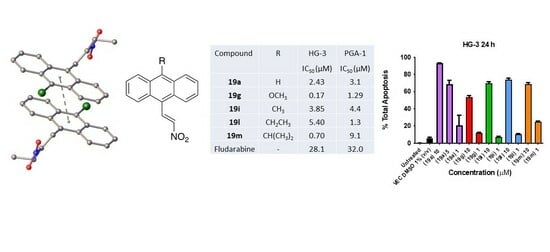Synthesis and Pro-Apoptotic Effects of Nitrovinylanthracenes and Related Compounds in Chronic Lymphocytic Leukaemia (CLL) and Burkitt’s Lymphoma (BL)
Abstract
1. Introduction
- i.
- The synthesis of a panel of nitrovinylanthracenes for initial BL evaluation to optimise the core structure for further CLL investigation;
- ii.
- The identification of a focussed panel of nitrostyrenes to confirm the efficacy of nitrostyrene pharmacophore in CLL;
- iii.
- The evaluation and optimisation of the antiproliferative activity of the selected nitrovinylanthracenes in CLL and related cell lines;
- iv.
- The determination of the pro-apoptotic effects of nitrovinylanthracenes in CLL cells.
2. Chemistry
2.1. In Vitro Antiproliferative Activity of Nitrosytrenes, Nitrovinylanthracenes and Related Compounds in Burkitt Lymphoma
2.2. Effect of Nitrostyrene 11h on the Viability of PBMCs
2.3. Effect of Pre-Treatment with N-Acetylcysteine and Caspase Inhibitor Z-VAD-FMK on Induction of Apoptosis by Compound 11h
2.4. In Vitro Antiproliferative Activity of the Nitrovinylanthracenes and Related Compounds in Burkitt’s Lymphoma
2.5. Physicochemical, ADME, Pharmacokinetic and Stability Properties of (E)-9-(2-Nitrovinyl)Anthracenes and Related Compounds
2.6. Evaluation of In Vitro Antiproliferative Activity of Nitrostyrenes and Anthracene-Based Maprotiline Analogues in Chronic Lymphocytic Leukaemia (CLL)
2.7. Antiproliferative Activity of Nitrostyrenes in HG-3 and PGA-1 CLL Cell Lines
2.8. Antiproliferative Activity of Anthracene-Based Maprotiline Analogues in HG-3 CLL Cell Line
2.9. Antiproliferative Activity of Anthracene-Based Maprotiline Analogues in PGA-1 CLL Cell Line
2.10. In Vitro IC50 Determination of the Most Potent (E)-9-(2-nitrovinyl)anthracene Derivatives in HG-3 Cells and PGA-1 Cells
2.11. In Vitro Antiproliferative Activity of Nitrovinylanthracenes in Estrogen-Receptor-Positive Breast Cancer Cell Lines MCF-7 and MDA-MB-231
2.12. Pro-Apoptotic Effects of Nitrostyrene Compounds 11g, 11h, 11i, 11j, 11k and 11l in MUTU-I and DG-75 BL Cell Lines
2.13. Pro-Apoptotic Effects of Nitrovinylanthracene Compounds 19a, 19g, 19i, 19l and 19m in HG-3 and PGA-1 CLL Cell Lines
2.14. Molecular Modelling
3. Experimental Section
3.1. 10-Isopropylanthracene-9-carbaldehyde (14b)
3.2. 9-(2-Methoxyvinyl)anthracene (17)
3.3. General Procedure for the Preparation of Nitrovinyl Anthracene Derivatives (19h-m, 20a, 20b)
3.3.1. (E)-9-Bromo-10-(2-Nitrovinyl)Anthracene (19h)
3.3.2. (E)-9-Methyl-10-(2-Nitrovinyl)Anthracene (19i)
3.3.3. (E)-9-(2-Nitrovinyl)-10-Phenylanthracene (19j)
3.3.4. (E)-1,8-Dichloro-10-(2-Nitrovinyl)Anthracene (19k)
3.3.5. (E)-9-Ethyl-10-(2-Nitrovinyl)Anthracene (19l)
3.3.6. (E)-9-Isopropyl-10-(2-Nitrovinyl)Anthracene (19m)
3.3.7. 9-(3-Nitroallyl)Anthracene (20a)
3.3.8. 9-(3-Nitrobut-2-en-1-yl)Anthracene (20b)
3.4. 9-(2-Nitroethyl)Anthracene (22)
3.5. 2-((10-Chloroanthracen-9-yl)Methylene)Malononitrile (23b)
3.6. 4-(Anthracen-9-yl)-5-Methyl-1H-1,2,3-Triazole (30b)
3.7. 4-(Anthracen-9-yl)-4,5-Dihydro-1H-1,2,3-Triazole (31)
3.8. Anthracen-9-yl(Azepan-1-yl)Methanone (33c)
4. Biochemistry
4.1. Materials
4.2. Cell Culture
4.3. AlamarBlue Cell Viability Assay
4.4. Generation of Human Peripheral Blood Mononuclear Cells (PBMCs)
4.5. Annexin V/PI Apoptotic Assay
4.6. Inhibitor Studies
4.7. X-ray Experimental Procedure
4.8. Computational Overlay Study
5. Conclusions
Supplementary Materials
Author Contributions
Funding
Institutional Review Board Statement
Informed Consent Statement
Data Availability Statement
Acknowledgments
Conflicts of Interest
Abbreviations
| BBB | Blood–brain barrier |
| BTK | Bruton’s tyrosine kinase |
| BL | Burkitt’s Lymphoma |
| CLL | Chronic lymphocytic leukaemia |
| CLL-IPI | CLL-international prognostic index |
| COSY | Correlated spectroscopy |
| DEPT | Distortionless enhancement by polarisation transfer |
| D-MEM | Dulbecco’s modified Eagle’s medium |
| DMSO | Dimethylsulfoxide |
| EBV | Epstein–Barr virus |
| ECACC | European Collection of Animal Cell Cultures |
| ER | Estrogen receptor |
| FACS | Fluorescence-activated cell sorting |
| FBS | Foetal bovine serum |
| FDA | The United States Food and Drug Administration |
| FITC | Fluorescein isothiocyanate |
| HEPES | N-2-Hydroxyethylpiperazine-N′-2-ethanesulfonic acid |
| HER2 | Human epidermal growth factor receptor 2 |
| HRMS | High-resolution mass spectrometry |
| IC50 | Half-maximal inhibitory concentration |
| IGVH | Immunoglobulin heavy-chain gene |
| IR | Infrared |
| MEM | Eagle’s minimum essential medium |
| 4-MTA | 4-Methylthioamphetamine |
| NHL | Non-Hodgkin’s lymphoma |
| NMR | Nuclear magnetic resonance |
| PBMCs | Peripheral blood mononuclear cells |
| PI | Propidium iodide |
| PR | Progesterone receptor |
| RPMI 1640 | Roswell Park Memorial Institute 1640 medium |
| RT | Richter’s transformation |
| SERT | Serotonin transporter |
| TBNC | Triple-negative breast cancers |
| TPSA | Topological polar surface area |
References
- Siegel, R.L.; Miller, K.D.; Fuchs, H.E.; Jemal, A. Cancer statistics, 2022. CA Cancer J. Clin. 2022, 72, 7–33. [Google Scholar] [CrossRef] [PubMed]
- Hallek, M.; Cheson, B.D.; Catovsky, D.; Caligaris-Cappio, F.; Dighiero, G.; Döhner, H.; Hillmen, P.; Keating, M.J.; Montserrat, E.; Rai, K.R. Guidelines for the diagnosis and treatment of chronic lymphocytic leukaemia: A report from the international workshop on Chronic Lymphocytic Leukaemia updating the National Cancer Institute–Working group 1996 guidelines. Blood 2008, 111, 5446–5456. [Google Scholar] [CrossRef] [PubMed]
- Devereux, S.; Cuthill, K. Chronic lymphocytic leukaemia. Medicine 2017, 45, 292–296. [Google Scholar] [CrossRef]
- Scarfò, L.; Ferreri, A.J.M.; Ghia, P. Chronic lymphocytic leukaemia. Crit. Rev. Oncol./Hematol. 2016, 104, 169–182. [Google Scholar] [CrossRef] [PubMed]
- Redaelli, A.; Laskin, B.L.; Stephens, J.M.; Botteman, M.F.; Pashos, C.L. The clinical and epidemiological burden of chronic lymphocytic leukaemia. Eur. J. Cancer Care 2004, 13, 279–287. [Google Scholar] [CrossRef] [PubMed]
- National Cancer Institute. Surveillance, Epidemiology, and End Results Program. Available online: https://seer.cancer.gov/statistics-network/ (accessed on 18 October 2023).
- Miranda-Filho, A.; Pineros, M.; Ferlay, J.; Soerjomataram, I.; Monnereau, A.; Bray, F. Epidemiological patterns of leukaemia in 184 countries: A population-based study. Lancet Haematol. 2018, 5, e14–e24. [Google Scholar] [CrossRef] [PubMed]
- Molica, S. Sex differences in incidence and outcome of chronic lymphocytic leukaemia patients. Leuk. Lymphoma 2006, 47, 1477–1480. [Google Scholar] [CrossRef]
- García-Escobar, I.; Sepúlveda, J.; Castellano, D.; Cortés-Funes, H. Therapeutic management of chronic lymphocytic leukaemia. Crit. Rev. Oncol./Hematol. 2011, 80, 100–113. [Google Scholar] [CrossRef]
- Puente, X.S.; Pinyol, M.; Quesada, V.; Conde, L.; Ordonez, G.R.; Villamor, N.; Escaramis, G.; Jares, P.; Bea, S.; Gonzalez-Diaz, M.; et al. Whole-genome sequencing identifies recurrent mutations in chronic lymphocytic leukaemia. Nature 2011, 475, 101–105. [Google Scholar] [CrossRef]
- Hallek, M.; Shanafelt, T.D.; Eichhorst, B. Chronic lymphocytic leukaemia. Lancet 2018, 391, 1524–1537. [Google Scholar] [CrossRef]
- Agathangelidis, A.; Chatzidimitriou, A.; Chatzikonstantinou, T.; Tresoldi, C.; Davis, Z.; Giudicelli, V.; Kossida, S.; Belessi, C.; Rosenquist, R.; Ghia, P.; et al. Immunoglobulin gene sequence analysis in chronic lymphocytic leukaemia: The 2022 update of the recommendations by ERIC, the European Research Initiative on CLL. Leukaemia 2022, 36, 1961–1968. [Google Scholar] [CrossRef] [PubMed]
- Lee, J.; Wang, Y.L. Prognostic and predictive molecular biomarkers in chronic lymphocytic leukaemia. J. Mol. Diagn. 2020, 22, 1114–1125. [Google Scholar] [CrossRef] [PubMed]
- Moia, R.; Patriarca, A.; Schipani, M.; Ferri, V.; Favini, C.; Sagiraju, S.; Al Essa, W.; Gaidano, G. Precision medicine management of chronic lymphocytic leukaemia. Cancers 2020, 12, 642. [Google Scholar] [CrossRef] [PubMed]
- Cohen, J.A.; Bomben, R.; Pozzo, F.; Tissino, E.; Harzschel, A.; Hartmann, T.N.; Zucchetto, A.; Gattei, V. An updated perspective on current prognostic and predictive biomarkers in chronic lymphocytic leukaemia in the context of chemoimmunotherapy and novel targeted therapy. Cancers 2020, 12, 894. [Google Scholar] [CrossRef] [PubMed]
- Hallek, M. Chronic lymphocytic leukaemia: 2020 update on diagnosis, risk stratification and treatment. Am. J. Hematol. 2019, 94, 1266–1287. [Google Scholar] [CrossRef] [PubMed]
- Roskoski, R., Jr. Ibrutinib inhibition of Bruton protein-tyrosine kinase (BTK) in the treatment of B cell neoplasms. Pharmacol. Res. 2016, 113, 395–408. [Google Scholar] [CrossRef] [PubMed]
- Sharman, J.P.; Coutre, S.E.; Furman, R.R.; Cheson, B.D.; Pagel, J.M.; Hillmen, P.; Barrientos, J.C.; Zelenetz, A.D.; Kipps, T.J.; Flinn, I.W.; et al. Final results of a randomized, phase III study of rituximab with or without idelalisib followed by open-label idelalisib in patients with relapsed chronic lymphocytic leukaemia. J. Clin. Oncol. 2019, 37, 1391–1402. [Google Scholar] [CrossRef]
- Somoza, J.R.; Koditek, D.; Villasenor, A.G.; Novikov, N.; Wong, M.H.; Liclican, A.; Xing, W.; Lagpacan, L.; Wang, R.; Schultz, B.E.; et al. Structural, biochemical, and biophysical characterization of idelalisib binding to phosphoinositide 3-kinase delta. J. Biol. Chem. 2015, 290, 8439–8446. [Google Scholar] [CrossRef]
- Souers, A.J.; Leverson, J.D.; Boghaert, E.R.; Ackler, S.L.; Catron, N.D.; Chen, J.; Dayton, B.D.; Ding, H.; Enschede, S.H.; Fairbrother, W.J.; et al. ABT-199, a potent and selective BCL-2 inhibitor, achieves antitumor activity while sparing platelets. Nat. Med. 2013, 19, 202–208. [Google Scholar] [CrossRef]
- Crawford, J.J.; Johnson, A.R.; Misner, D.L.; Belmont, L.D.; Castanedo, G.; Choy, R.; Coraggio, M.; Dong, L.; Eigenbrot, C.; Erickson, R.; et al. Discovery of GDC-0853: A potent, selective, and noncovalent Bruton’s tyrosine kinase inhibitor in early clinical development. J. Med. Chem. 2018, 61, 2227–2245. [Google Scholar] [CrossRef]
- Mato, A.R.; Shah, N.N.; Jurczak, W.; Cheah, C.Y.; Pagel, J.M.; Woyach, J.A.; Fakhri, B.; Eyre, T.A.; Lamanna, N.; Patel, M.R.; et al. Pirtobrutinib in relapsed or refractory B-cell malignancies (BRUIN): A phase 1/2 study. Lancet 2021, 397, 892–901. [Google Scholar] [CrossRef] [PubMed]
- Abbas, H.A.; Wierda, W.G. Acalabrutinib: A selective bruton tyrosine kinase inhibitor for the treatment of B-cell malignancies. Front. Oncol. 2021, 11, 668162. [Google Scholar] [CrossRef] [PubMed]
- Brown, J.R.; Eichhorst, B.; Hillmen, P.; Jurczak, W.; Kazmierczak, M.; Lamanna, N.; O’Brien, S.M.; Tam, C.S.; Qiu, L.; Zhou, K.; et al. Zanubrutinib or ibrutinib in relapsed or refractory chronic lymphocytic leukaemia. N. Engl. J. Med. 2023, 388, 319–332. [Google Scholar] [CrossRef] [PubMed]
- Freeman, C.L.; Gribben, J.G. Immunotherapy in chronic lymphocytic leukaemia (CLL). Curr. Hematol. Malig. Rep. 2016, 11, 29–36. [Google Scholar] [CrossRef] [PubMed][Green Version]
- Parikh, S.A. Chronic lymphocytic leukaemia treatment algorithm 2018. Blood Cancer J. 2018, 8, 93. [Google Scholar] [CrossRef] [PubMed]
- Younes, A.; Brody, J.; Carpio, C.; Lopez-Guillermo, A.; Ben-Yehuda, D.; Ferhanoglu, B.; Nagler, A.; Ozcan, M.; Avivi, I.; Bosch, F.; et al. Safety and activity of ibrutinib in combination with nivolumab in patients with relapsed non-Hodgkin lymphoma or chronic lymphocytic leukaemia: A phase 1/2a study. Lancet Haematol. 2019, 6, e67–e78. [Google Scholar] [CrossRef] [PubMed]
- Ding, W.; LaPlant, B.R.; Call, T.G.; Parikh, S.A.; Leis, J.F.; He, R.; Shanafelt, T.D.; Sinha, S.; Le-Rademacher, J.; Feldman, A.L.; et al. Pembrolizumab in patients with CLL and Richter transformation or with relapsed CLL. Blood 2017, 129, 3419–3427. [Google Scholar] [CrossRef] [PubMed]
- Skånland, S.S.; Mato, A.R. Overcoming resistance to targeted therapies in chronic lymphocytic leukaemia. Blood Adv. 2021, 5, 334–343. [Google Scholar] [CrossRef]
- McElligott, A.M.; Maginn, E.N.; Greene, L.M.; McGuckin, S.; Hayat, A.; Browne, P.V.; Butini, S.; Campiani, G.; Catherwood, M.A.; Vandenberghe, E.; et al. The novel tubulin-targeting agent pyrrolo-1,5-benzoxazepine-15 induces apoptosis in poor prognostic subgroups of chronic lymphocytic leukaemia. Cancer Res. 2009, 69, 8366–8375. [Google Scholar] [CrossRef]
- Ferla, S.; Aboraia, A.S.; Brancale, A.; Pepper, C.J.; Zhu, J.; Ochalek, J.T.; DeLuca, H.F.; Simons, C. Small-molecule inhibitors of 25-hydroxyvitamin D-24-hydroxylase (CYP24A1): Synthesis and biological evaluation. J. Med. Chem. 2014, 57, 7702–7715. [Google Scholar] [CrossRef]
- Dozzo, M.; Carobolante, F.; Donisi, P.M.; Scattolin, A.; Maino, E.; Sancetta, R.; Viero, P.; Bassan, R. Burkitt lymphoma in adolescents and young adults: Management challenges. Adolesc. Health Med. Ther. 2017, 8, 11–29. [Google Scholar] [CrossRef] [PubMed]
- Della Rocca, A.M.; Leonart, L.P.; Ferreira, V.L.; Tonin, F.S.; Steffenello-Durigon, G.; Del Moral, J.A.G.; Fernandez-Llimos, F.; Pontarolo, R. Chemotherapy treatments for Burkitt lymphoma: Systematic review of interventional studies. Clin. Lymphoma Myeloma Leuk. 2021, 21, 514–525. [Google Scholar] [CrossRef] [PubMed]
- Phase II Study of Dose-Adjusted Epoch-Rituximab in Adults with Untreated Burkitt Lymphoma and c-MYC+ Diffuse Large B-Cell Lymphoma-Full Text view-clinicaltrials.gov. Available online: http://clinicaltrials.Gov/ct2/show/nct01092182?Term=burkitt+lymphoma&rank=1 (accessed on 9 October 2023).
- Chemotherapy Plus Rituximab Combination for Adult Lymphoblastic Leukaemia (B-ALL) and Burkitt’s Non-Hodgkin Lymphoma-Full Text view-clinicaltrials.gov. Available online: http://clinicaltrials.Gov/ct2/show/nct01290120?Term=burkitt+lymphoma&rank=2 (accessed on 9 October 2023).
- Guech-Ongey, M.; Simard, E.P.; Anderson, W.F.; Engels, E.A.; Bhatia, K.; Devesa, S.S.; Mbulaiteye, S.M. AIDS-related Burkitt lymphoma in the United States: What do age and CD4 lymphocyte patterns tell us about etiology and/or biology? Blood 2010, 116, 5600–5604. [Google Scholar] [CrossRef] [PubMed]
- Anderton, E.; Yee, J.; Smith, P.; Crook, T.; White, R.E.; Allday, M.J. Two Epstein-Barr virus (EBV) oncoproteins cooperate to repress expression of the proapoptotic tumour-suppressor Bim: Clues to the pathogenesis of Burkitt’s lymphoma. Oncogene 2008, 27, 421–433. [Google Scholar] [CrossRef] [PubMed]
- Johnson, P.C.; Abramson, J.S. Current treatment of Burkitt lymphoma and high-grade b-cell lymphomas. Oncology 2022, 36, 499–505. [Google Scholar] [PubMed]
- Byrne, A.J.; Bright, S.A.; Fayne, D.; McKeown, J.P.; McCabe, T.; Twamley, B.; Williams, C.; Meegan, M.J. Synthesis, antiproliferative and pro-apoptotic effects of nitrostyrenes and related compounds in Burkitt’s lymphoma. Med. Chem. 2018, 14, 181–199. [Google Scholar] [CrossRef] [PubMed]
- Byrne, A.J.; Bright, S.A.; McKeown, J.P.; O’Brien, J.E.; Twamley, B.; Fayne, D.; Williams, D.C.; Meegan, M.J. Design, synthesis and biochemical evaluation of novel ethanoanthracenes and related compounds to target Burkitt’s lymphoma. Pharmaceuticals 2020, 13, 16. [Google Scholar] [CrossRef] [PubMed]
- McNamara, Y.M.; Bright, S.A.; Byrne, A.J.; Cloonan, S.M.; McCabe, T.; Williams, D.C.; Meegan, M.J. Synthesis and antiproliferative action of a novel series of maprotiline analogues. Eur. J. Med. Chem. 2014, 71, 333–353. [Google Scholar] [CrossRef]
- McNamara, Y.M.; Cloonan, S.M.; Knox, A.J.; Keating, J.J.; Butler, S.G.; Peters, G.H.; Meegan, M.J.; Williams, D.C. Synthesis and serotonin transporter activity of 1,3-bis(aryl)-2-nitro-1-propenes as a new class of anticancer agents. Bioorg. Med. Chem. 2011, 19, 1328–1348. [Google Scholar] [CrossRef]
- Cloonan, S.M.; Keating, J.J.; Butler, S.G.; Knox, A.J.; Jorgensen, A.M.; Peters, G.H.; Rai, D.; Corrigan, D.; Lloyd, D.G.; Williams, D.C.; et al. Synthesis and serotonin transporter activity of sulphur-substituted alpha-alkyl phenethylamines as a new class of anticancer agents. Eur. J. Med. Chem. 2009, 44, 4862–4888. [Google Scholar] [CrossRef]
- Cloonan, S.M.; Williams, D.C. The antidepressants maprotiline and fluoxetine induce type ii autophagic cell death in drug-resistant Burkitt’s lymphoma. Int. J. Cancer 2011, 128, 1712–1723. [Google Scholar] [CrossRef] [PubMed]
- Bright, S.A.; Byrne, A.J.; Vandenberghe, E.; Browne, P.V.; McElligott, A.M.; Meegan, M.J.; Williams, D.C. Selected nitrostyrene compounds demonstrate potent activity in chronic lymphocytic leukaemia cells, including those with poor prognostic markers. Oncol. Rep. 2019, 41, 3127–3136. [Google Scholar] [CrossRef] [PubMed]
- Noriega, S.; Cardoso-Ortiz, J.; Lopez-Luna, A.; Cuevas-Flores, M.D.R.; Flores De La Torre, J.A. The diverse biological activity of recently synthesized nitro compounds. Pharmaceuticals 2022, 15, 717. [Google Scholar] [CrossRef] [PubMed]
- Morrell, A.; Placzek, M.; Parmley, S.; Antony, S.; Dexheimer, T.S.; Pommier, Y.; Cushman, M. Nitrated indenoisoquinolines as topoisomerase I inhibitors: A systematic study and optimization. J. Med. Chem. 2007, 50, 4419–4430. [Google Scholar] [CrossRef] [PubMed]
- Tan, S.; He, F.; Kong, T.; Wu, J.; Liu, Z. Design, synthesis and tumor cell growth inhibitory activity of 3-nitro-2H-cheromene derivatives as histone deacetylaes inhibitors. Bioorg. Med. Chem. 2017, 25, 4123–4132. [Google Scholar] [CrossRef] [PubMed]
- Zhu, R.; Liu, M.C.; Luo, M.Z.; Penketh, P.G.; Baumann, R.P.; Shyam, K.; Sartorelli, A.C. 4-nitrobenzyloxycarbonyl derivatives of O(6)-benzylguanine as hypoxia-activated prodrug inhibitors of O(6)-alkylguanine-DNA alkyltransferase (AGT), which produces resistance to agents targeting the O-6 position of DNA guanine. J. Med. Chem. 2011, 54, 7720–7728. [Google Scholar] [CrossRef] [PubMed]
- Zheng, Y.B.; Gong, J.H.; Liu, X.J.; Wu, S.Y.; Li, Y.; Xu, X.D.; Shang, B.Y.; Zhou, J.M.; Zhu, Z.L.; Si, S.Y.; et al. A novel nitrobenzoate microtubule inhibitor that overcomes multidrug resistance exhibits antitumor activity. Sci. Rep. 2016, 6, 31472. [Google Scholar] [CrossRef]
- Winn, B.A.; Shi, Z.; Carlson, G.J.; Wang, Y.; Nguyen, B.L.; Kelly, E.M.; Ross, R.D.t.; Hamel, E.; Chaplin, D.J.; Trawick, M.L.; et al. Bioreductively activatable prodrug conjugates of phenstatin designed to target tumor hypoxia. Bioorg. Med. Chem. Lett. 2017, 27, 636–641. [Google Scholar] [CrossRef]
- Mohan, R.; Rastogi, N.; Namboothiri, I.N.; Mobin, S.M.; Panda, D. Synthesis and evaluation of alpha-hydroxymethylated conjugated nitroalkenes for their anticancer activity: Inhibition of cell proliferation by targeting microtubules. Bioorg. Med. Chem. 2006, 14, 8073–8085. [Google Scholar] [CrossRef]
- Coban, T.; Robertson, C.; Schwikkard, S.; Singer, R.; LeGresley, A. Synthesis and evaluation of bis(imino)anthracene derivatives as G-quadruplex ligands. RSC Med. Chem. 2021, 12, 751–757. [Google Scholar] [CrossRef]
- Baviera, G.S.; Donate, P.M. Recent advances in the syntheses of anthracene derivatives. Beilstein J. Org. Chem. 2021, 17, 2028–2050. [Google Scholar] [CrossRef] [PubMed]
- Ikeda, T.; Lee, B.; Tazuke, S.; Takenaka, A. Time-resolved observation of excitation hopping between two anthryl moieties attached to both ends of alkanes: Simulation based on conformational analysis. J. Am. Chem. Soc. 1990, 112, 4650–4656. [Google Scholar] [CrossRef]
- Pirkle, W.H.; Finn, J.M. Useful routes to 9-anthryl ethers and sulfides. J. Org. Chem. 1983, 48, 2779–2780. [Google Scholar] [CrossRef]
- Kuhn, R.; Fischer, H. Cumulenes. XIII. Amalgam-hydrogenation of cumulenes and prototropic rearrangements. Chem. Ber. 1961, 94, 3060–3071. [Google Scholar] [CrossRef]
- Stogryn, E.L. Synthesis and antimalarial activity of anthracene amino alcohols. J. Med. Chem. 1974, 17, 563–565. [Google Scholar] [CrossRef] [PubMed]
- Stern, D.; Finkelmeier, N.; Stalke, D. Assessment of the lix salt-effect in anthracenyl lithiums. Chem. Commun. 2011, 47, 2113–2115. [Google Scholar] [CrossRef] [PubMed]
- Ooyama, Y.; Uenaka, K.; Matsugasako, A.; Harima, Y.; Ohshita, J. Molecular design and synthesis of fluorescence PET (photo-induced electron transfer) sensors for detection of water in organic solvents. RSC Adv. 2013, 3, 23255–23263. [Google Scholar] [CrossRef]
- Jiang, H.; Rodriguez-Escrich, C.; Johansen, T.K.; Davis, R.L.; Jorgensen, K.A. Organocatalytic activation of polycyclic aromatic compounds for asymmetric Diels-Alder reactions. Angew. Chem. Int. Ed. Engl. 2012, 51, 10271–10274. [Google Scholar] [CrossRef]
- Parker, M.A.; Kurrasch, D.M.; Nichols, D.E. The role of lipophilicity in determining binding affinity and functional activity for 5-HT2A receptor ligands. Bioorg. Med. Chem. 2008, 16, 4661–4669. [Google Scholar] [CrossRef]
- Reichert, B.; Wegner, E. Β-nitrodicarboxylic esters and their conversion into oxidopyrrolidines. Ber. Dtsch. Chem. Ges. B 1938, 71B, 1254–1259. [Google Scholar] [CrossRef]
- Guillon, J.; Ronga, L.; Marchivie, M.; Moreau, S. Crystal structure of (E)-1-(3,4-methylenedioxy-6-fluorophenyl)-2-nitropropene. X-ray Struct. Anal. Online 2016, 32, 23–24. [Google Scholar] [CrossRef][Green Version]
- Hamdellou, L.; Hernandez, O.; Meinnel, J. 4-Dimethylamino-beta-nitrostyrene and 4-dimethylamino-beta-ethyl-beta-nitro-styrene at 100 k. Acta Crystallogr. Sect. C-Cryst. Struct. Commun. 2006, 62, O557–O560. [Google Scholar] [CrossRef] [PubMed]
- Kumar, N.N.B.; Chakravarty, M.; Kumar, N.S.; Sajna, K.V.; Swamy, K.C.K. Allenylphosphonates with a 1,3,2-dioxaphosphorinane ring: Synthesis, structures, stability and utility. J. Chem. Sci. 2009, 121, 23–36. [Google Scholar] [CrossRef]
- Andrews, S.P.; Ladlow, M. Convenient preparation and use of a new analytical construct for the analysis and development of solid-phase chemistries. J. Org. Chem. 2003, 68, 5525–5533. [Google Scholar] [CrossRef] [PubMed]
- Wawzonek, S.; Hallum, J.V. Abnormal Beckmann rearrangement of 9,10-dihydro-9,10-(11-oxoethano)anthracene oxime. J. Org. Chem. 1959, 24, 364–366. [Google Scholar] [CrossRef]
- Mase, N.; Takabe, K.; Tanaka, F. Fluorogenic probes for chemical transformations: 9-anthracene derivatives for monitoring reaction progress by an increase in fluorescence. Tetrahedron Lett. 2013, 54, 4306–4308. [Google Scholar] [CrossRef]
- Smith, P.A. Azides and Nitrenes: Reactivity and Utility; Academic Press Inc.: Orlando, FL, USA, 1984. [Google Scholar]
- Daniele, M.A.; Bandera, Y.P.; Foulger, S.H. Manipulation of Forster energy transfer of coupled fluorophores through biotransformation by Pseudomonas resinovorans CA10. Photochem. Photobiol. 2012, 88, 129–134. [Google Scholar] [CrossRef]
- Sridhar, G.; Somnath, M.; Sharma, G.V.M.; Prashanth, T. ZrCl4-mediated synthesis of 1,2,3-triazoles from vinyl nitrates and their biological evaluation. Synth. Commun. 2017, 47, 551–556. [Google Scholar] [CrossRef]
- Gupta, M.; Gupta, M.; Paul, S.; Kant, R.; Gupta, V.K. One-pot synthesis of 1,4-disubstituted 1,2,3-triazoles via Huisgen 1,3-dipolar cycloaddition catalysed by SiO2-Cu(I) oxide and single crystal x-ray analysis of 1-benzyl-4-phenyl-1H-1,2,3-triazole. Monatshefte Chem. 2015, 146, 143–148. [Google Scholar] [CrossRef]
- Molecular Operating Environment (MOE), version 2022.02; Chemical Computing Group Inc.: Montreal, QC, Canada, 2022.
- Baell, J.B.; Nissink, J.W.M. Seven year itch: Pan-assay interference compounds (PAINS) in 2017-utility and limitations. ACS Chem. Biol. 2018, 13, 36–44. [Google Scholar] [CrossRef]
- Davis, A.; Ward, S.E. The Handbook of Medicinal Chemistry: Principles and Practice; Royal Society of Chemistry: London, UK, 2014. [Google Scholar]
- Shultz, M.D. Two decades under the influence of the rule of five and the changing properties of approved oral drugs. J. Med. Chem. 2019, 62, 1701–1714. [Google Scholar] [CrossRef] [PubMed]
- Rosen, A.; Bergh, A.C.; Gogok, P.; Evaldsson, C.; Myhrinder, A.L.; Hellqvist, E.; Rasul, A.; Bjorkholm, M.; Jansson, M.; Mansouri, L.; et al. Lymphoblastoid cell line with B1 cell characteristics established from a chronic lymphocytic leukaemia clone by in vitro EBV infection. Oncoimmunology 2012, 1, 18–27. [Google Scholar] [CrossRef] [PubMed]
- Lewin, N.; Aman, P.; Mellstedt, H.; Zech, L.; Klein, G. Direct outgrowth of in vivo Epstein-Barr virus (EBV)-infected chronic lymphocytic leukaemia (CLL) cells into permanent lines. Int. J. Cancer 1988, 41, 892–895. [Google Scholar] [CrossRef] [PubMed]
- Yin, L.; Duan, J.J.; Bian, X.W.; Yu, S.C. Triple-negative breast cancer molecular subtyping and treatment progress. Breast Cancer Res. 2020, 22, 61. [Google Scholar] [CrossRef] [PubMed]
- Reddel, R.R.; Murphy, L.C.; Hall, R.E.; Sutherland, R.L. Differential sensitivity of human breast cancer cell lines to the growth-inhibitory effects of tamoxifen. Cancer Res. 1985, 45, 1525–1531. [Google Scholar] [PubMed]
- Keely, N.O.; Carr, M.; Yassin, B.; Ana, G.; Lloyd, D.G.; Zisterer, D.; Meegan, M.J. Design, synthesis and biochemical evaluation of novel selective estrogen receptor ligand conjugates incorporating an endoxifen-combretastatin hybrid scaffold. Biomedicines 2016, 4, 15. [Google Scholar] [CrossRef] [PubMed]
- Samadi, N.; Ghanbari, P.; Mohseni, M.; Tabasinezhad, M.; Sharifi, S.; Nazemieh, H.; Rashidi, M.R. Combination therapy increases the efficacy of docetaxel, vinblastine and tamoxifen in cancer cells. J. Cancer Res. Ther. 2014, 10, 715–721. [Google Scholar] [CrossRef]
- Omega 4.2.2.0. Openeye, Cadence Molecular Sciences, Santa Fe, NM, USA. Available online: http://www.eyesopen.com (accessed on 25 September 2023).
- Cloonan, S.M.; Drozgowska, A.; Fayne, D.; Williams, D.C. The antidepressants maprotiline and fluoxetine have potent selective antiproliferative effects against Burkitt lymphoma independently of the norepinephrine and serotonin transporters. Leuk. Lymphoma 2010, 51, 523–539. [Google Scholar] [CrossRef]
- FastROCS. Available online: http://www.eyesopen.com/fastrocs (accessed on 25 September 2023).
- Itamar, W.; Halpern, M. Alkylation via aromatization of ketones by phase-transfer catalysis. Synthesis 1979, 3, 177. [Google Scholar]
- Cox, P.J.; Sim, G.A. X-ray diffraction studies of 9-methylanthraecene and 5-methylnaphthacene. Acta Cryst. 1979, B35, 404–410. [Google Scholar] [CrossRef]
- Vila, C.; Giannerini, M.; Hornillos, V.; Fananas-Mastral, M.; Feringa, B.L. Palladium-catalysed direct cross-coupling of secondary alkyllithium reagents. Chem. Sci. 2014, 5, 1361. [Google Scholar] [CrossRef]
- Iwahara, H.; Kushida, T.; Yamaguchi, S. A planarized 9-phenylanthracene: A simple electron-donating building block for fluorescent materials, S. Chem. Commun. 2016, 52, 1124. [Google Scholar] [CrossRef] [PubMed]
- Martin, V.H. Bulletin des Societes Chimiques Belges; Sociétés Chimiques: Brussels, Belgium, 1952; Volume 61, pp. 504–511. [Google Scholar]
- Norman, R.O.C.; Waters, W.A. Action of the phenyl radical on anthracene and meso-substituted anthracenes. J. Chem. Soc. 1958, 167–170. [Google Scholar] [CrossRef]
- Jayachitra, K.; JobePrabakar, P.C.; Ramalingam, S. Vibrational, NMR and UV–Visible spectroscopic investigation on 10-methylanthracene 9-carbaldehyde using computational calculations. J. Mol. Struct. 2020, 1217, 128435. [Google Scholar] [CrossRef]
- Jones, S.; Atherton, J.C.C. An improved procedure for the preparation of 9,10-dibromoanthracene. Synth. Commun. 2001, 31, 1799–1802. [Google Scholar] [CrossRef]
- House, H.O.; Ghali, N.I.; Haack, J.L.; VanDerveer, D. Reactions of the 1,8-diphenylanthracene system. J. Org. Chem. 1980, 45, 1807–1817. [Google Scholar] [CrossRef]
- Becker, H.D.; Hansen, L.; Andersson, K. Synthesis and photochemical isomerization of 1,2-di-9-anthrylethanol and 1,2-di-9-anthrylethanone. J. Org. Chem. 1986, 51, 2956–2961. [Google Scholar] [CrossRef]
- Koremura, M.; Oku, H.; Shono, T.; Nakanishi, T. Relation between chemical structure and antimicrobial and insecticidal activities in organonitro compounds. VIII. Synthesis of heterocyclic nitroalkene derivatives and their activities. Takamine Kenkyusho Nenpo 1961, 13, 216–221. [Google Scholar]
- Becker, H.D.; Skelton, B.W.; Sorensen, H.; White, A.H. Photochemical cis-trans Isomerization of 2-Substituted 9-(2-nitroethenyl)anthracenes. X-ray structure analyses of (E)- and (Z)-9-(2-nitro-2-phenylethenyl)anthracene. Aust. J. Chem. 1989, 42, 593–601. [Google Scholar] [CrossRef]
- Nakajima, S.; Osuka, A. Synthesis of a tetrakis(9-anthryl) substituted porphyrin and intramolecular charge-transfer emission in its dication. Tetrahedron Lett. 1995, 36, 8457–8460. [Google Scholar] [CrossRef]
- Misra, R.; Sharma, R.; Bhattacharyya, S.P. Exploring NLO response of 9,10-donor-acceptor substituted bichromophoric anthracene derivatives. J. Comput. Methods Sci. Eng. 2010, 10, 149–164. [Google Scholar] [CrossRef]
- Zee-Cheng, K.-Y.; Cheng, C.C. Experimental tumor inhibitors. Antitumor activity of esters of ω-aryl-y-nitro-y-alken-1-ol and related compounds. J. Med. Chem. 1969, 12, 157–161. [Google Scholar] [CrossRef] [PubMed]
- Lock, G.; Stach, K. Catalytic decomposition of hydrazones. I. Aromatic aldehyde hydrazones. Ber. Dtsch. Chem. Ges. B 1943, 76B, 1252–1256. [Google Scholar] [CrossRef]
- Zhang, X.M.; Bordwell, F.G.; Bares, J.E.; Cheng, J.P.; Petrie, B.C. Homolytic bond dissociation energies of the acidic carbon-hydrogen bonds in alpha-substituted and 10-substituted 9-methylanthracenes and their related radical anions. J. Org. Chem. 1993, 58, 3051–3059. [Google Scholar] [CrossRef]
- Rescifina, A.; Chiacchio, M.A.; Corsaro, A.; De Clercq, E.; Iannazzo, D.; Mastino, A.; Piperno, A.; Romeo, G.; Romeo, R.; Valveri, V. Synthesis and biological activity of isoxazolidinyl polycyclic aromatic hydrocarbons: Potential DNA intercalators. J. Med. Chem. 2006, 49, 709–715. [Google Scholar] [CrossRef] [PubMed]
- Kabalka, G.W.; Goudgaon, N.M. A facile aldoxime preparation via the reduction of α,β-unsaturated nitroalkenes using tin(II) chloride. Synth. Commun. 1988, 18, 693–697. [Google Scholar] [CrossRef]
- Jiang, L.; Fu, Y.; Li, H.; Hu, W. Single-crystalline, size, and orientation controllable nanowires and ultralong microwires of organic semiconductor with strong photoswitching property. J. Am. Chem. Soc. 2008, 130, 3937–3941. [Google Scholar] [CrossRef]
- Hann, R.A. Use of dimethylformamide as a solvent for the Knoevenagel reaction. J.Chem. Soc. Perkin Trans. 1974, 1379–1380. [Google Scholar] [CrossRef]
- Metayer, M. Hydrogenation of 9-anthraldehyde. Bull. Soc. Chim. Fr. 1954, 614–615. [Google Scholar]
- Zhang, J.-Q.; Liu, J.; Hu, D.; Song, J.; Zhu, G.; Ren, H. Rapid and simple access to α-(hetero)arylacetonitriles from gem- difluoroalkenes. Org. Lett. 2022, 24, 786–790. [Google Scholar] [CrossRef] [PubMed]
- Mathew, R.; Mallia, R.R.; Haridas, S.; Jacob, J.P. Effect of substituents on the fluorescence quenching of a few (anthracen-9-yl)methanamines. J. Photochem. Photobiol. A Chem. 2020, 397, 112552. [Google Scholar] [CrossRef]
- Clayden, J.; Frampton, C.S.; McCarthy, C.; Westlund, N. Perilithiation and the synthesis of 8-substituted-1-naphthamides. Tetrahedron 1999, 55, 14161–14184. [Google Scholar] [CrossRef]
- Karthikeyan, J.; Yoshikai, N. Rhodium(III)-catalyzed directed peri-C-H alkenylation of anthracene derivatives. Org. Lett. 2014, 16, 4224–4227. [Google Scholar] [CrossRef] [PubMed]
- Lo, K.; Cornell, H.; Nicoletti, G.; Jackson, N.; Hügel, H. A study of fluorinated β-nitrostyrenes as antimicrobial agents. Appl. Sci. 2012, 2, 114–128. [Google Scholar] [CrossRef]
- Si, T.; Kim, H.Y.; Oh, K. Substrate promiscuity of ortho-naphthoquinone catalyst: Catalytic aerobic amine oxidation protocols to deaminative cross-coupling and N-nitrosation. ACS Catal. 2019, 9, 9216–9221. [Google Scholar] [CrossRef]
- Sen, P.K.; Sikha, L.; Chattopadhyay, G.; Mandal, D.K. Oxidation of 10-methoxy-9-anthraldehyde with various oxidizing agents in protic and aprotic media. Indian J. Chem. 1989, 28B, 978–979. [Google Scholar] [CrossRef]
- Lanemo Myhrinder, A.; Hellqvist, E.; Sidorova, E.; Soderberg, A.; Baxendale, H.; Dahle, C.; Willander, K.; Tobin, G.; Backman, E.; Soderberg, O.; et al. A new perspective: Molecular motifs on oxidized LDL, apoptotic cells, and bacteria are targets for chronic lymphocytic leukaemia antibodies. Blood 2008, 111, 3838–3848. [Google Scholar] [CrossRef]
- Brophy, S.; Amet, R.; Foy-Stones, H.; Gardiner, N.; McElligott, A.M. Isolation and cryopreservation of mononuclear cells from peripheral blood and bone marrow of blood cancer patients. Methods Mol. Biol. 2023, 2645, 179–187. [Google Scholar]
- Apex3 and Apex4, Bruker (2017) and Bruker (2021). Bruker AXS Inc.: Madison, WI, USA.
- Krause, L.; Herbst-Irmer, R.; Sheldrick, G.M.; Stalke, D. Comparison of silver and molybdenum microfocus X-ray sources for single-crystal structure determination. J. Appl. Crystallogr. 2015, 48, 3–10. [Google Scholar] [CrossRef]
- Sheldrick, G.M. SHELXT-integrated space-group and crystal-structure determination. Acta Crystallogr. A Found. Adv. 2015, 71, 3–8. [Google Scholar] [CrossRef]
- Sheldrick, G.M. Crystal structure refinement with SHELXL. Acta Crystallogr. C Struct. Chem. 2015, 71, 3–8. [Google Scholar] [CrossRef]
- Dolomanov, O.V.; Bourhis, L.J.; Gildea, R.J.; Howard, J.A.K.; Puschmann, H. Olex2: A complete structure solution, refinement and analysis program. J. Appl. Crystallogr. 2009, 42, 339–341. [Google Scholar] [CrossRef]
- Hawkins, P.C.; Skillman, A.G.; Warren, G.L.; Ellingson, B.A.; Stahl, M.T. Conformer generation with OMEGA: Algorithm and validation using high quality structures from the protein databank and Cambridge structural database. J. Chem. Inf. Model. 2010, 50, 572–584. [Google Scholar] [CrossRef]

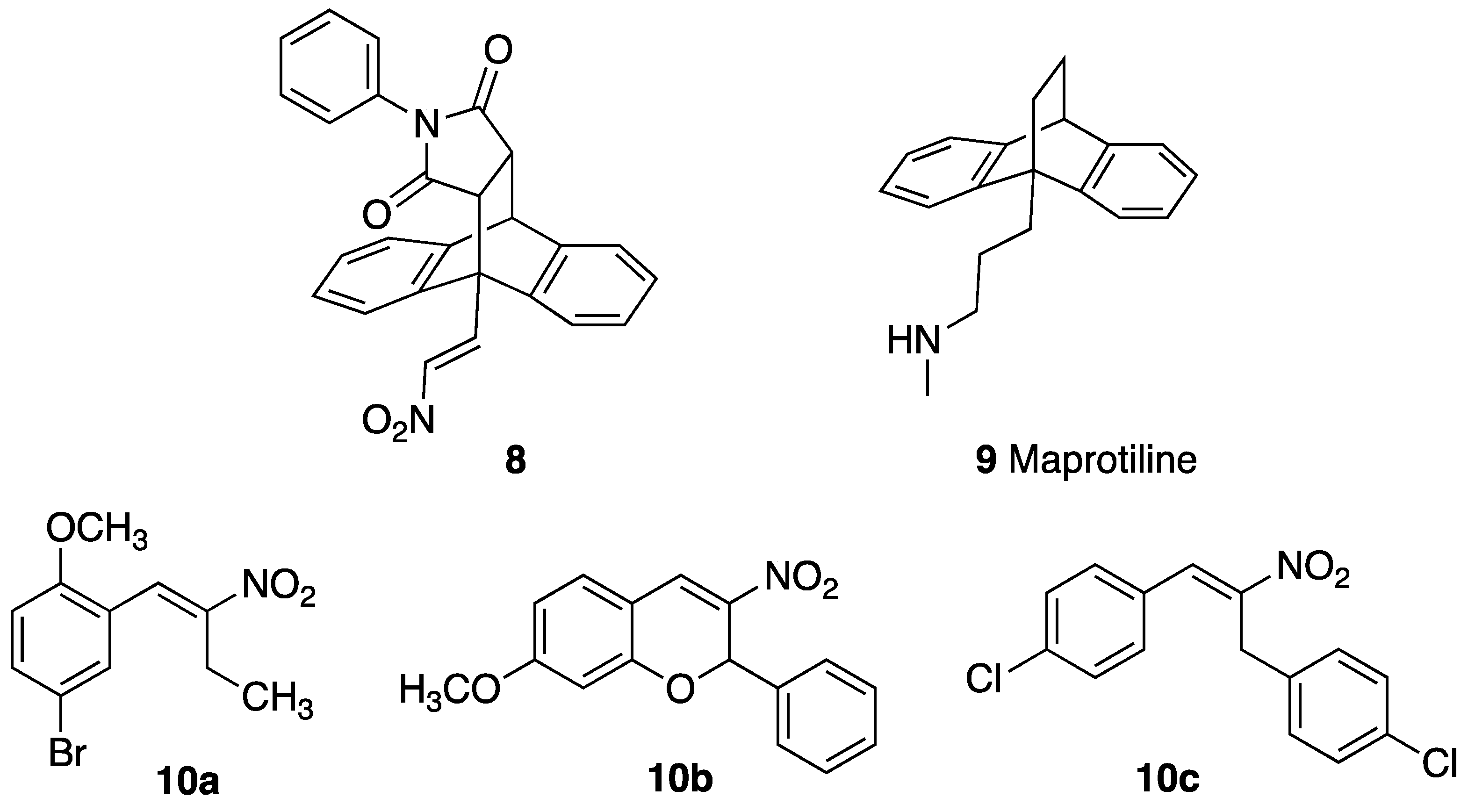

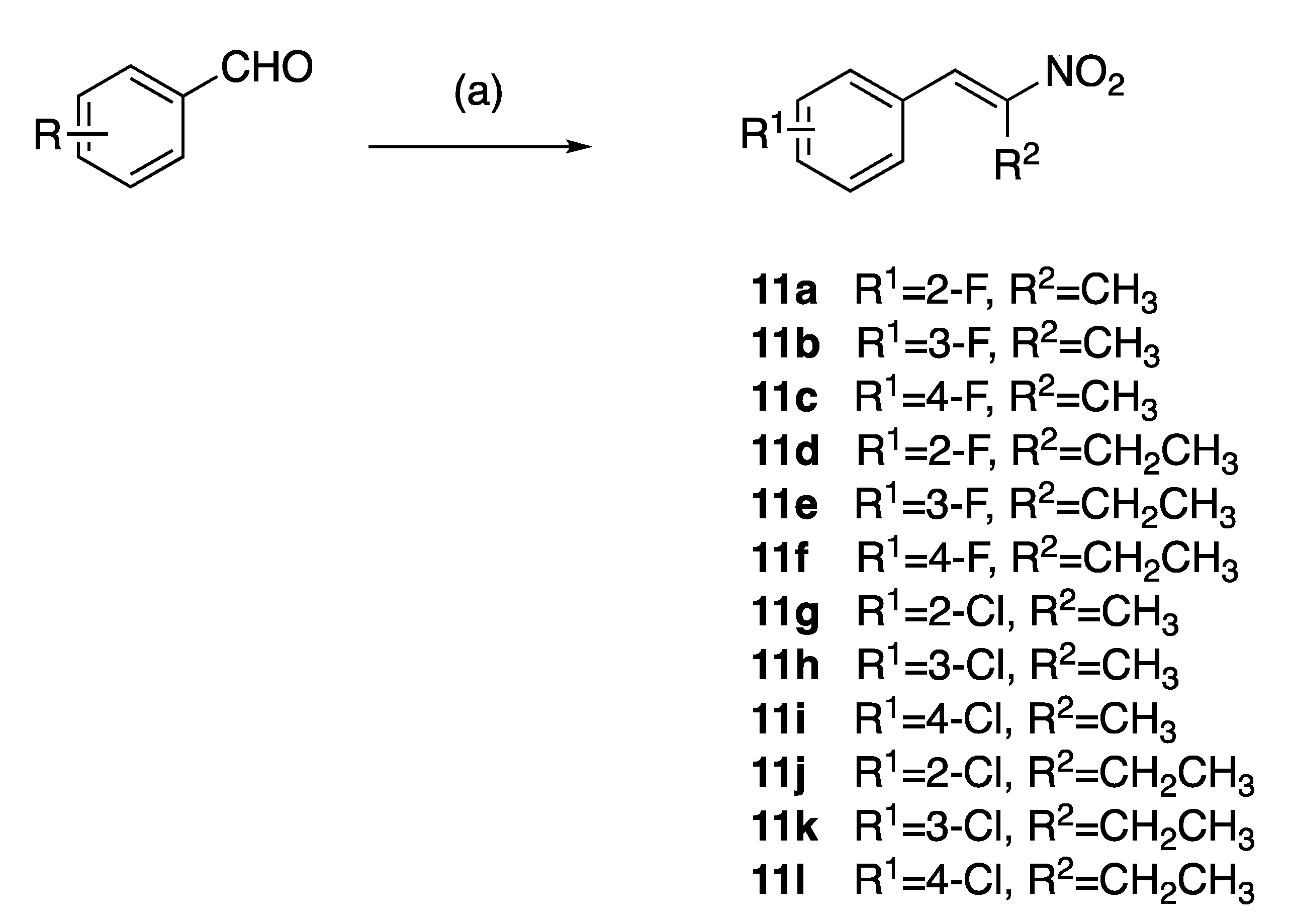

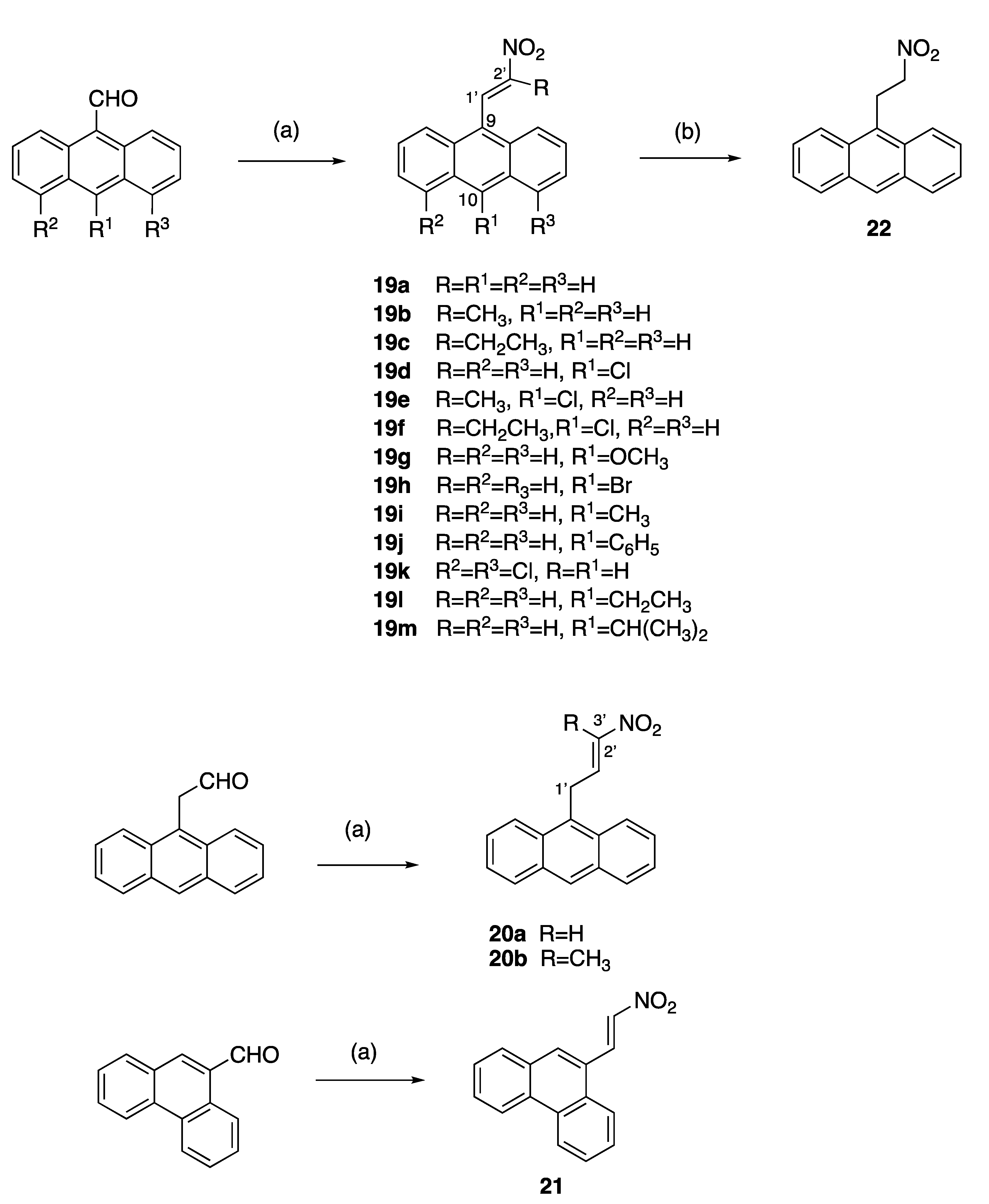
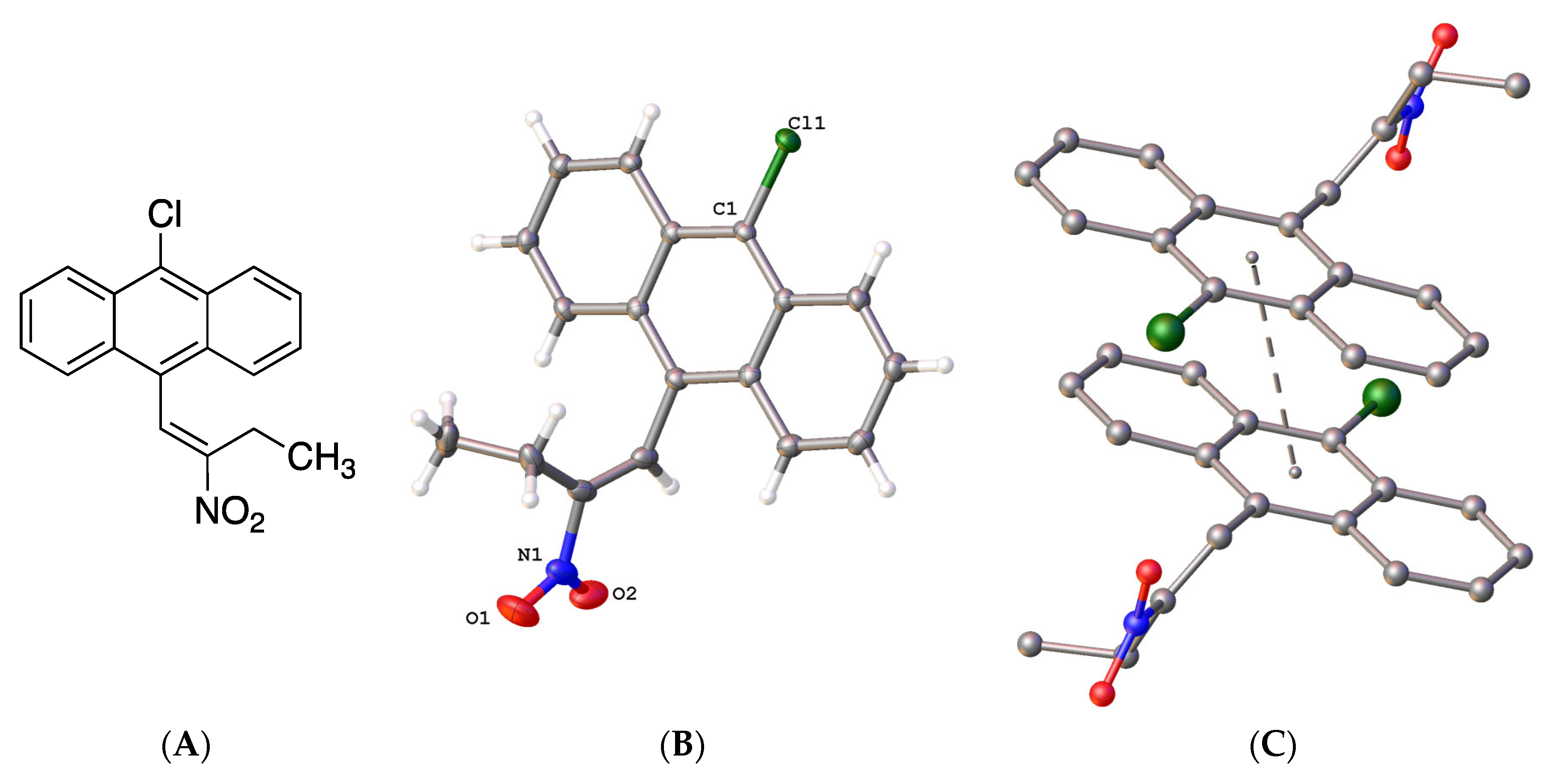
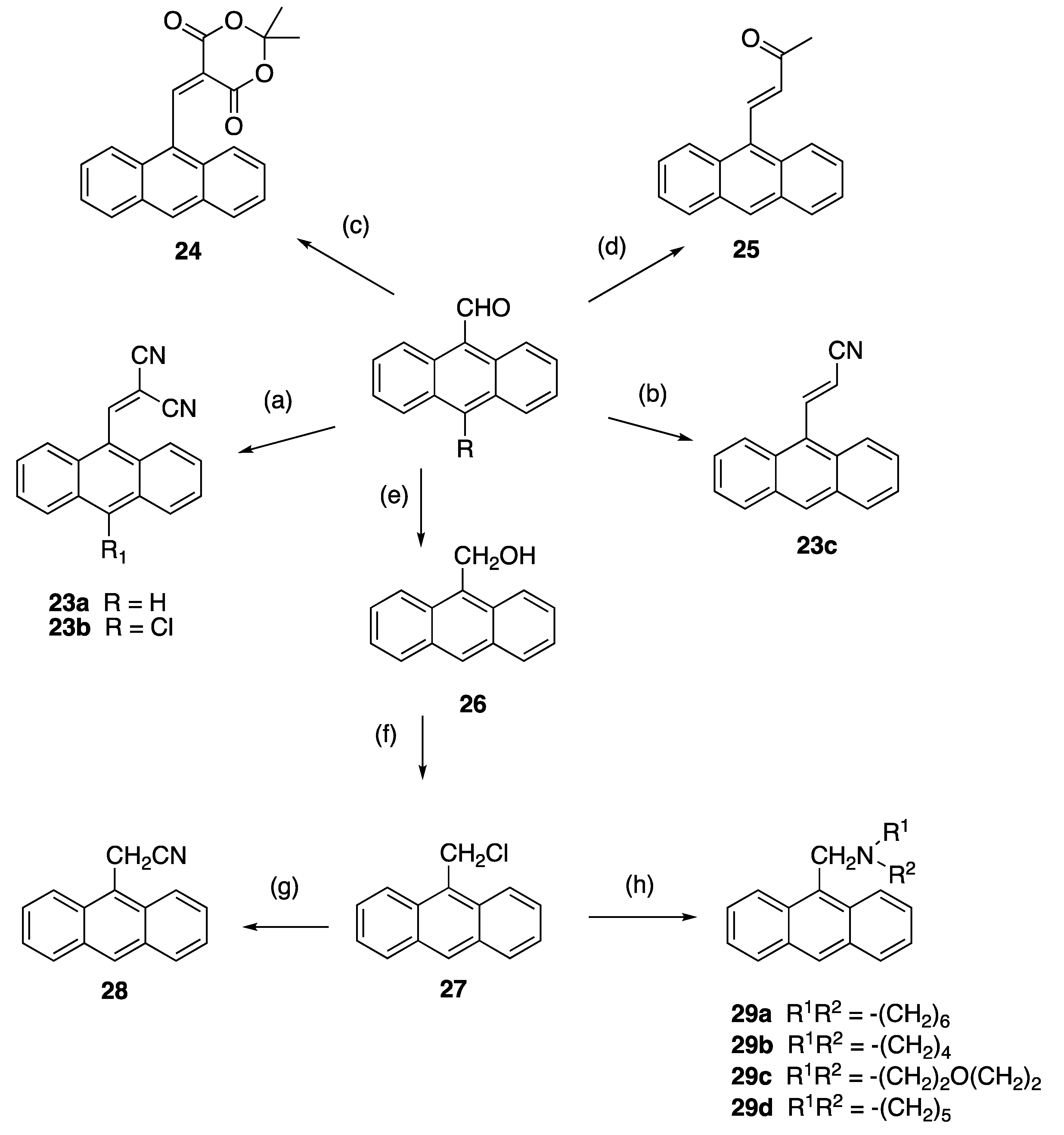
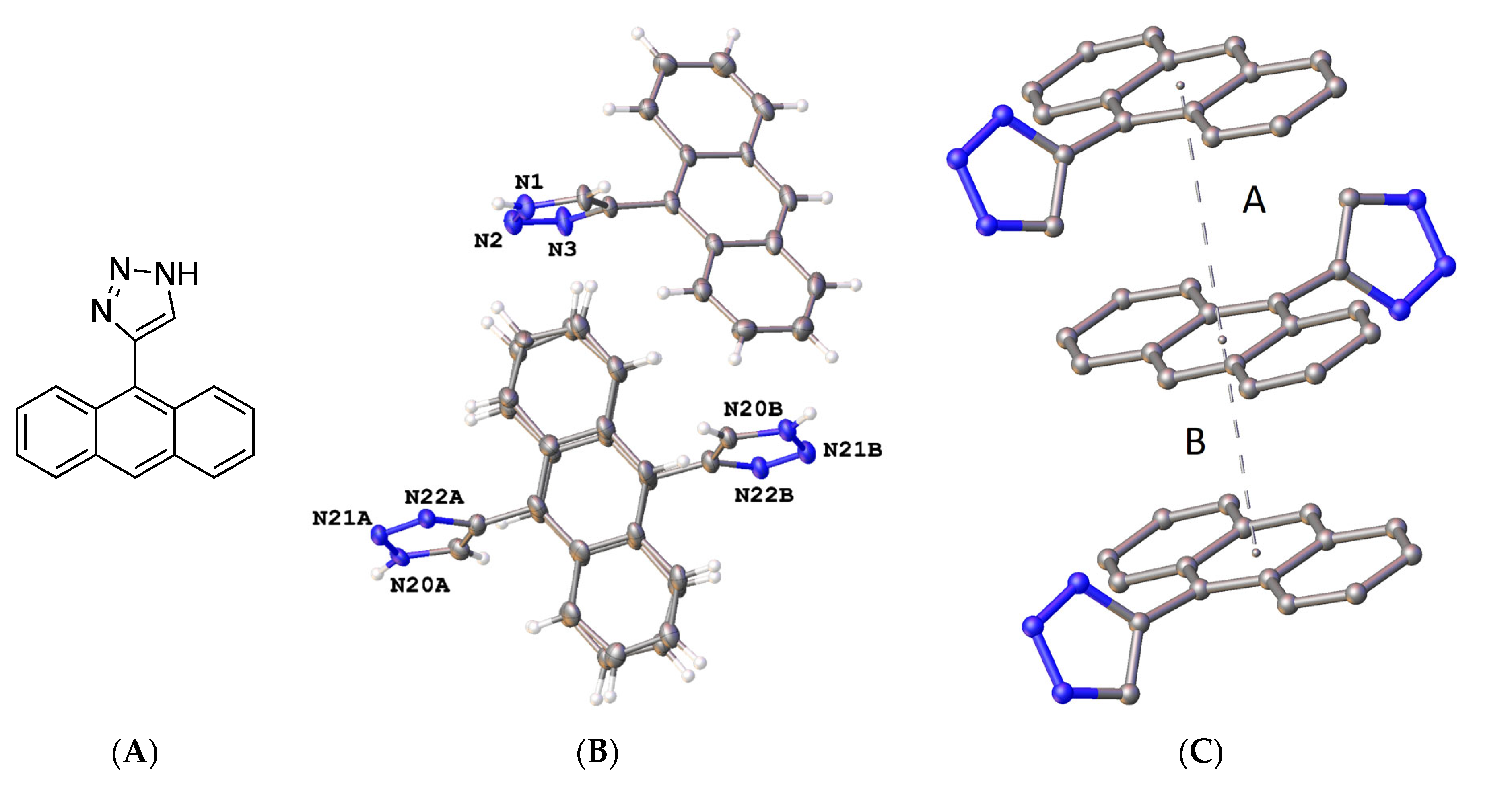

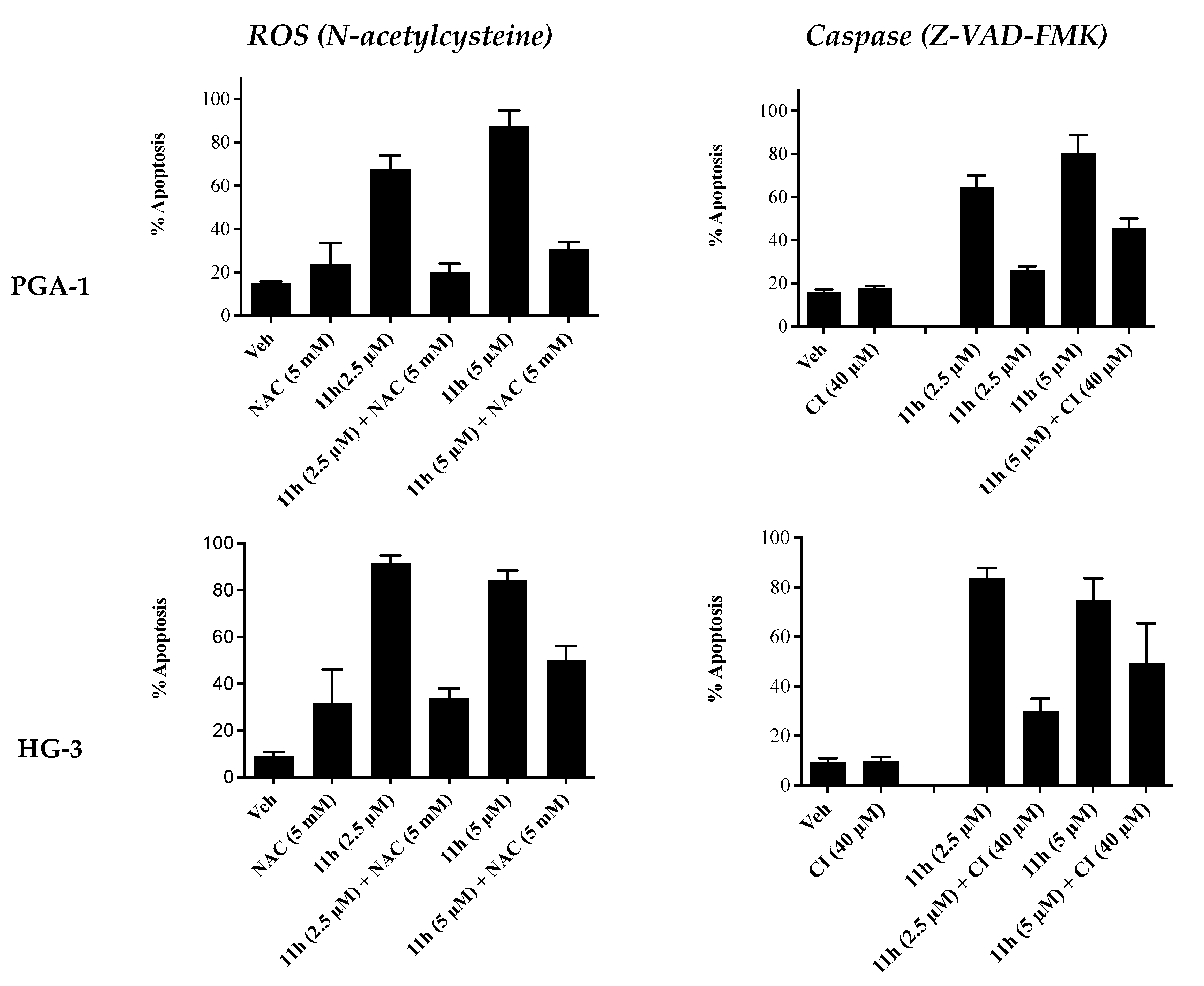
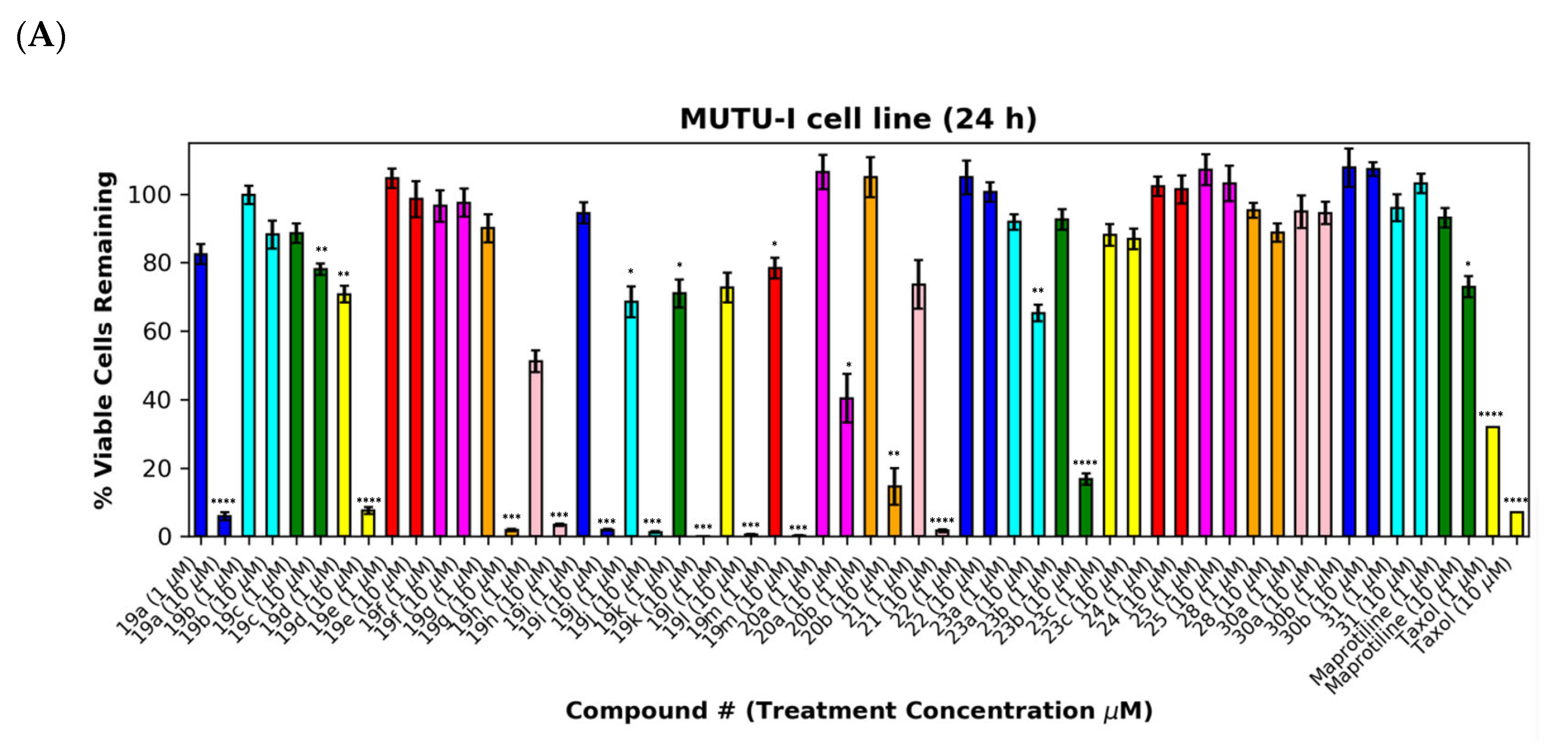
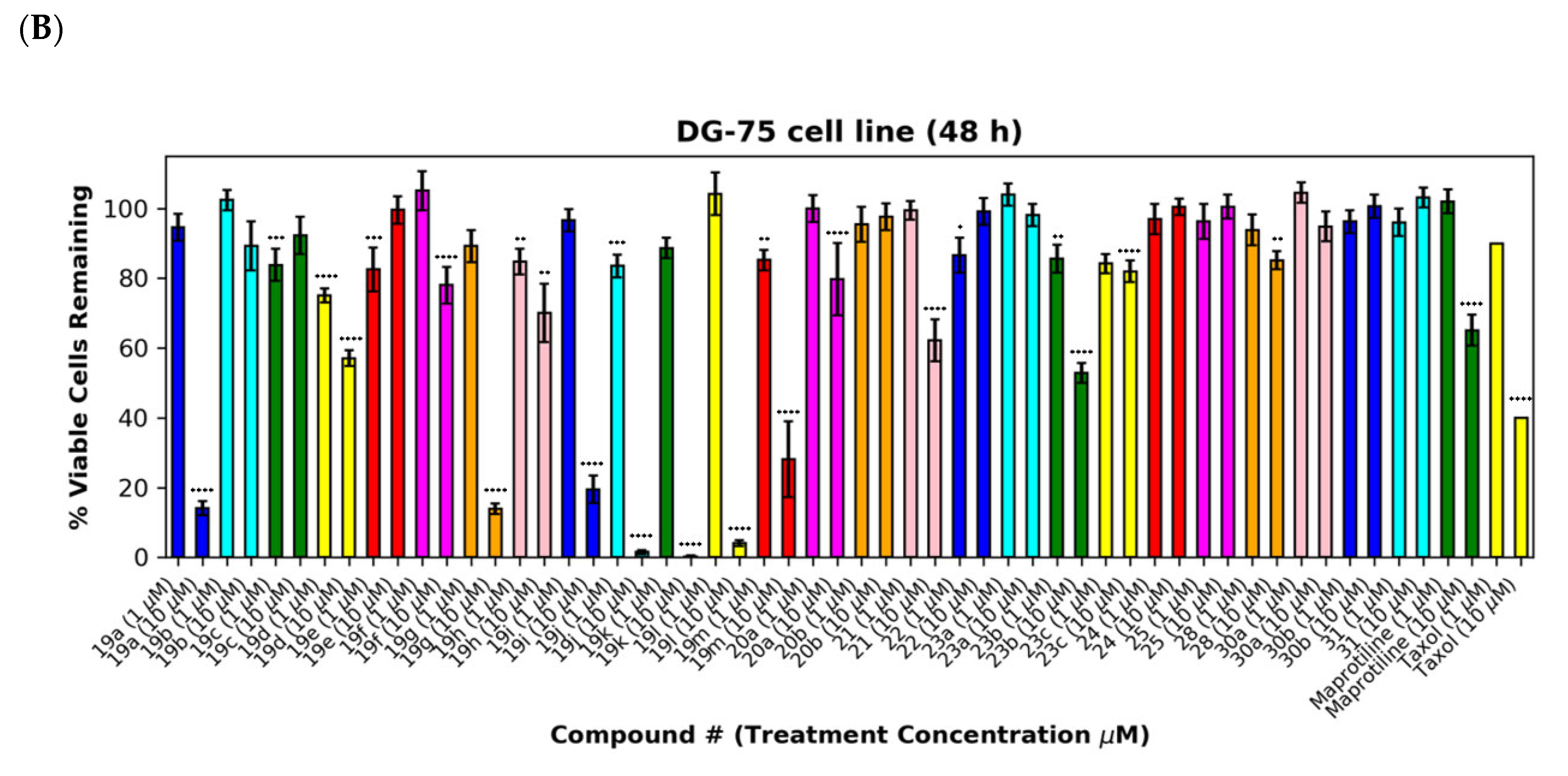

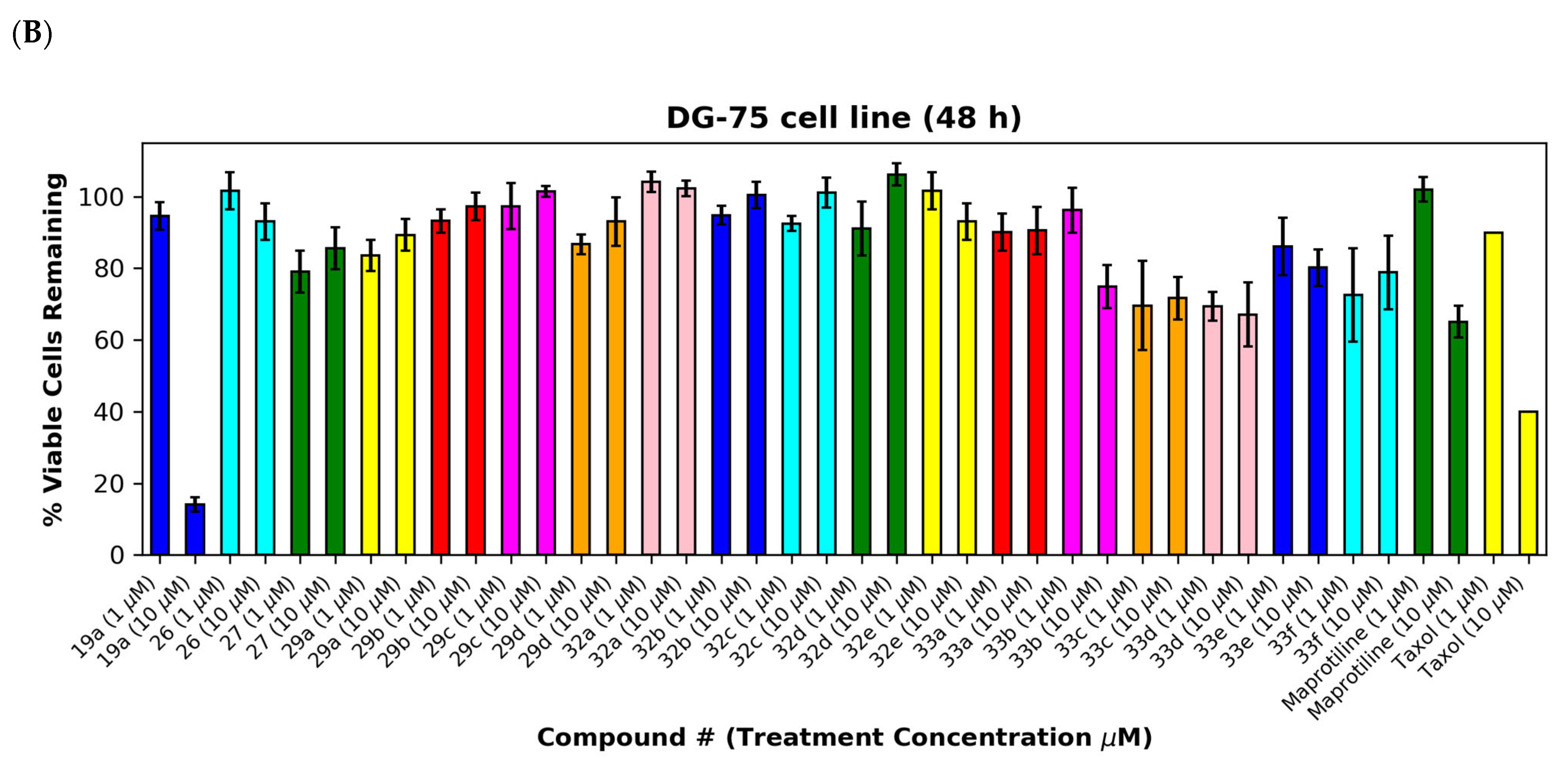
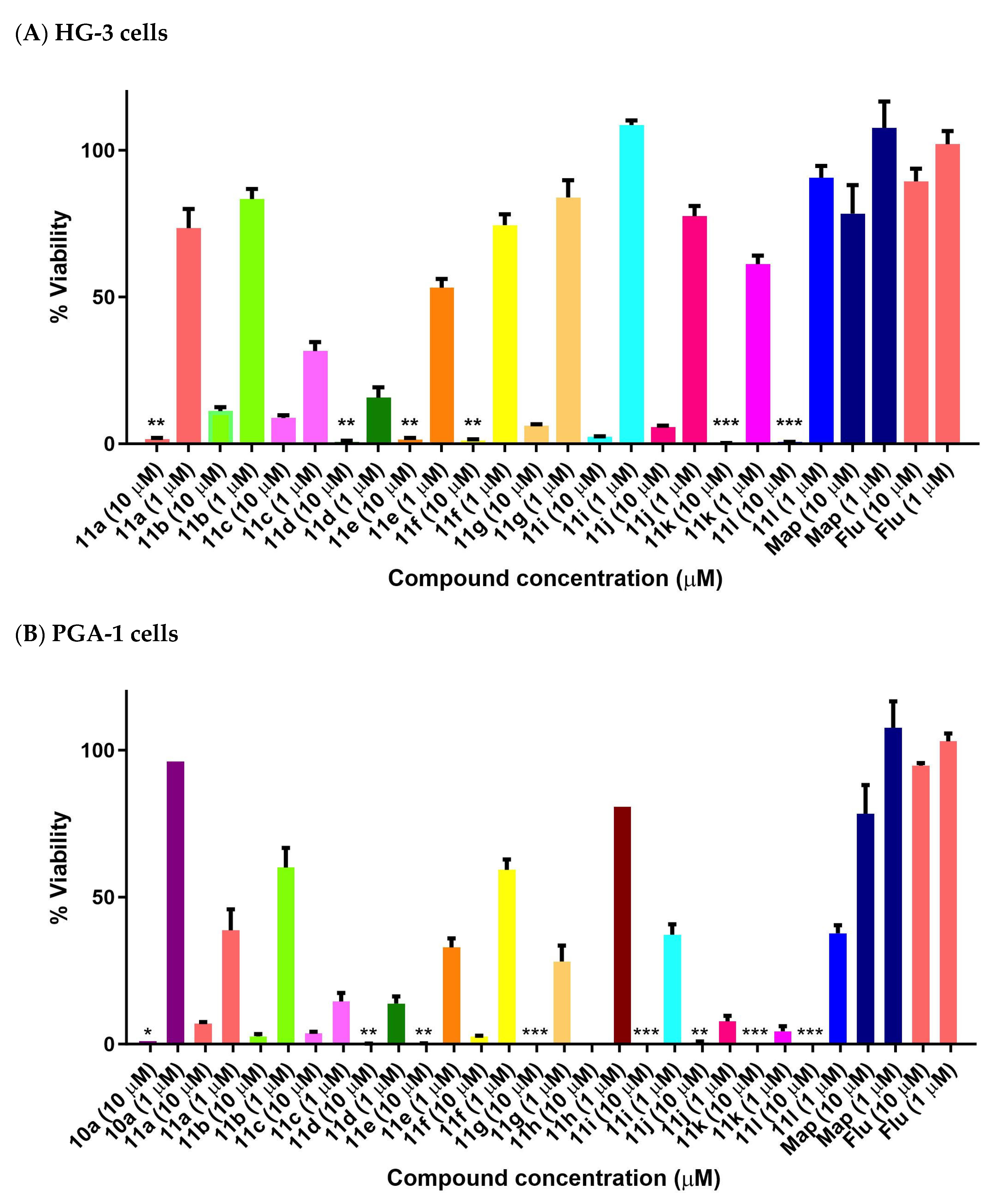
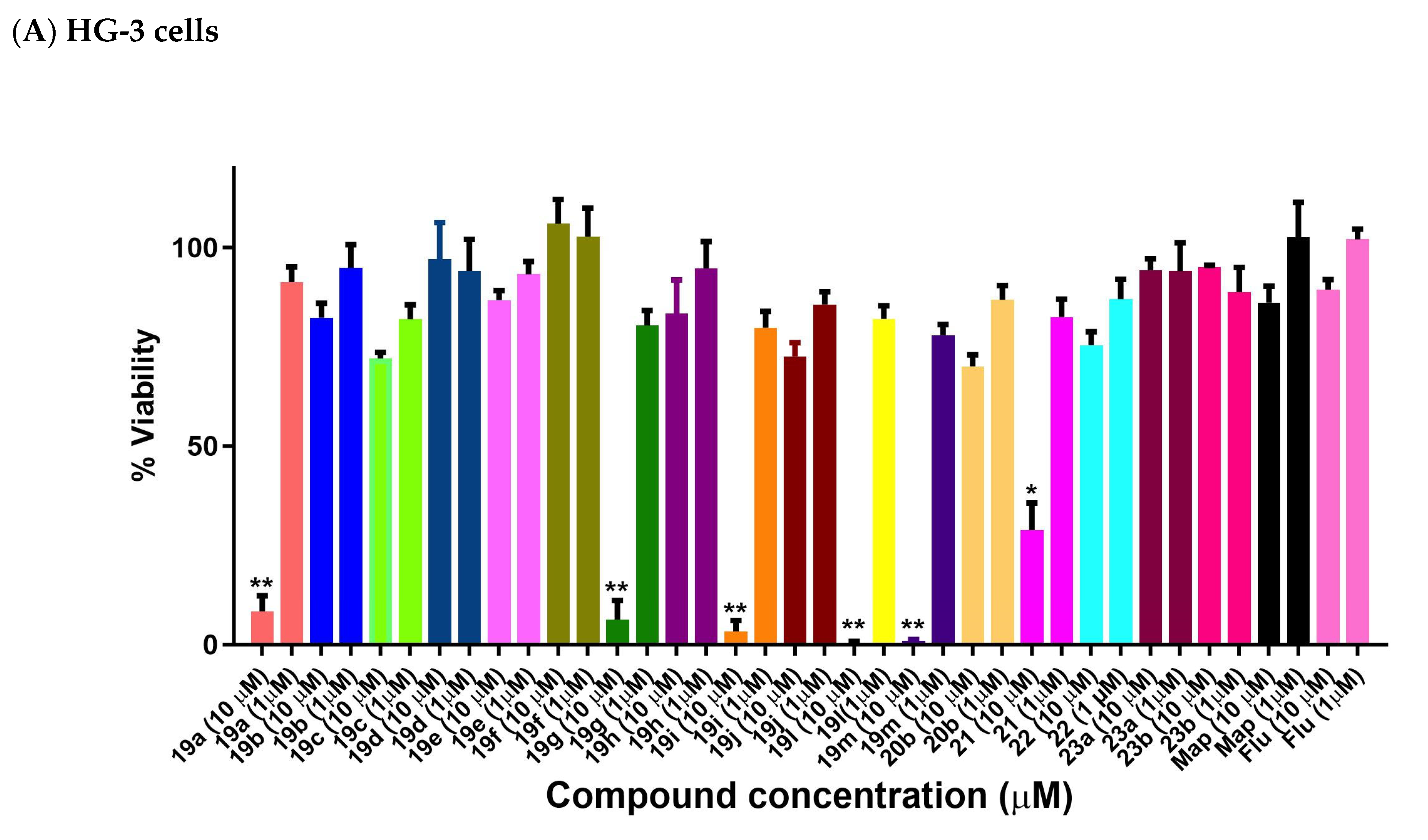
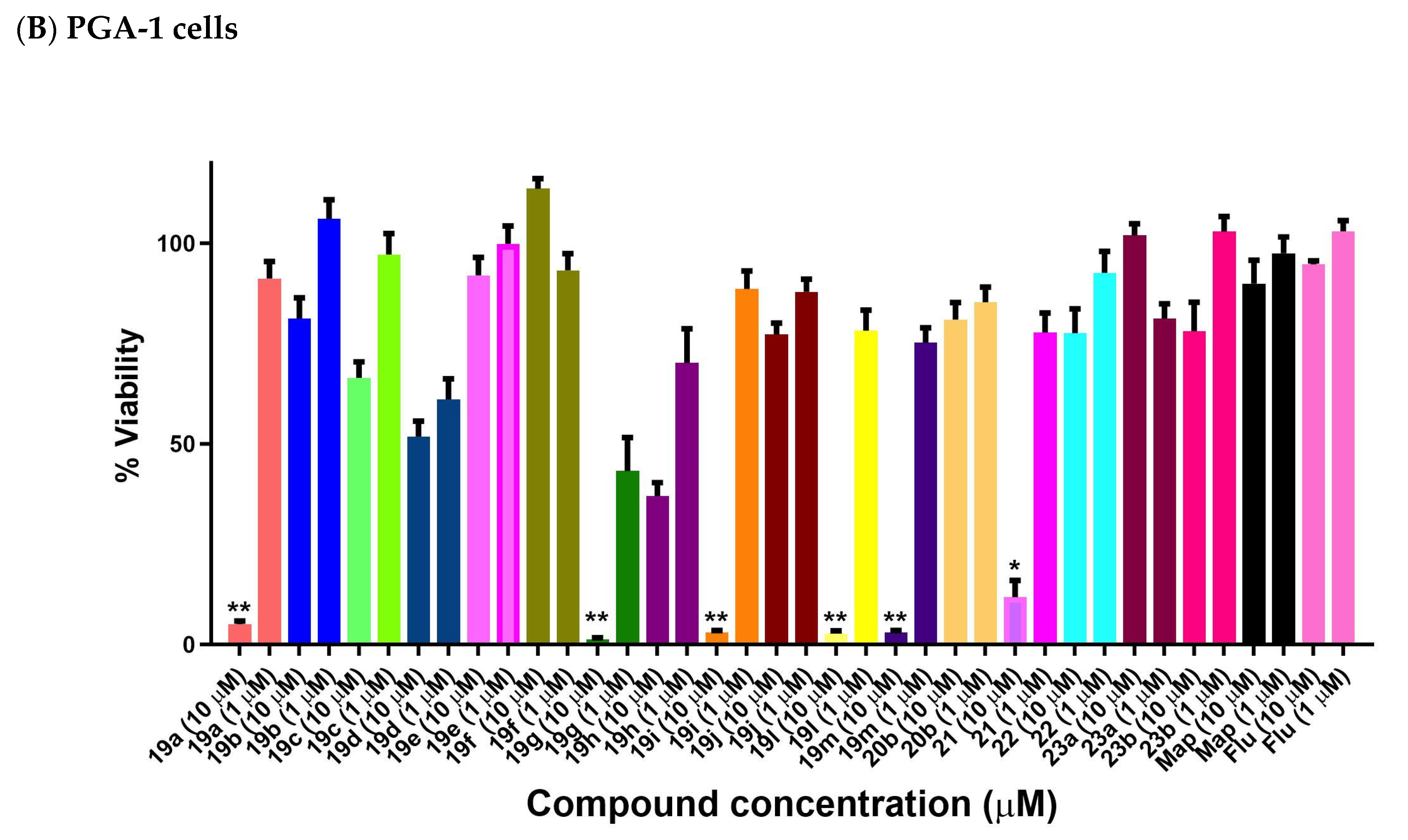
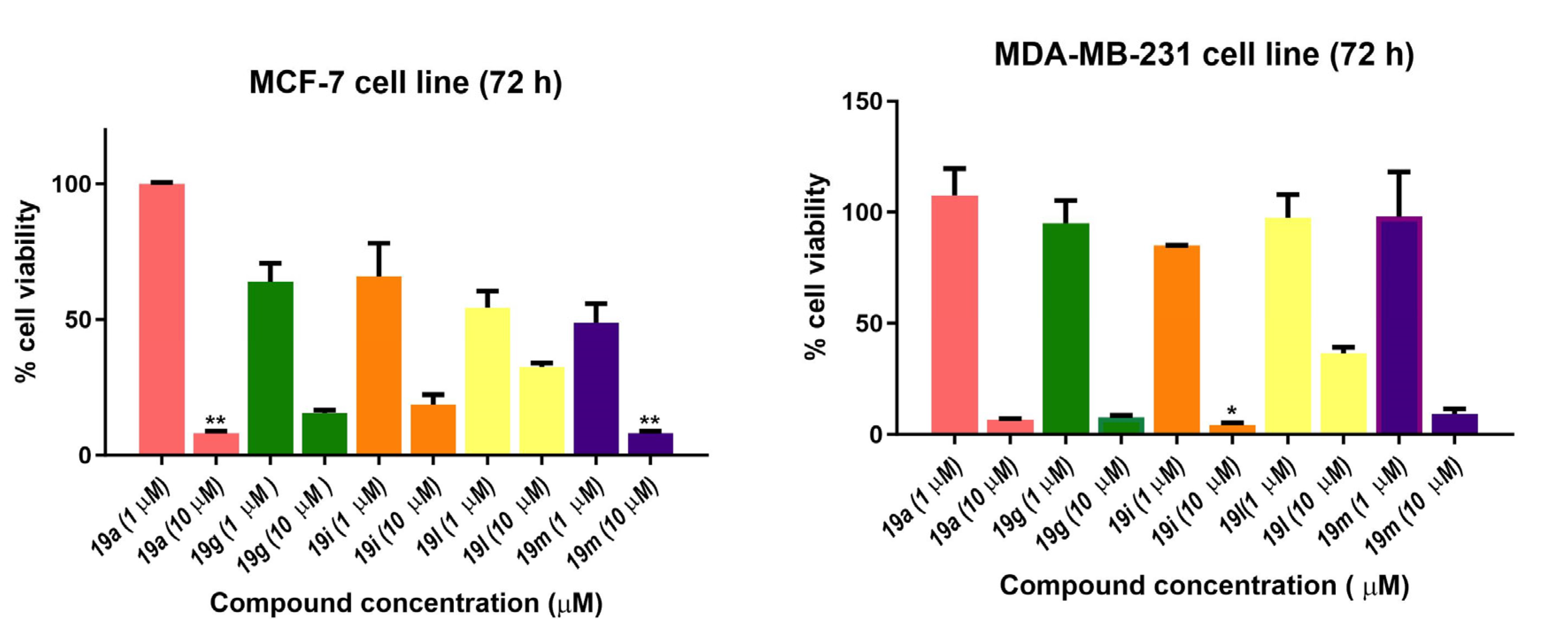
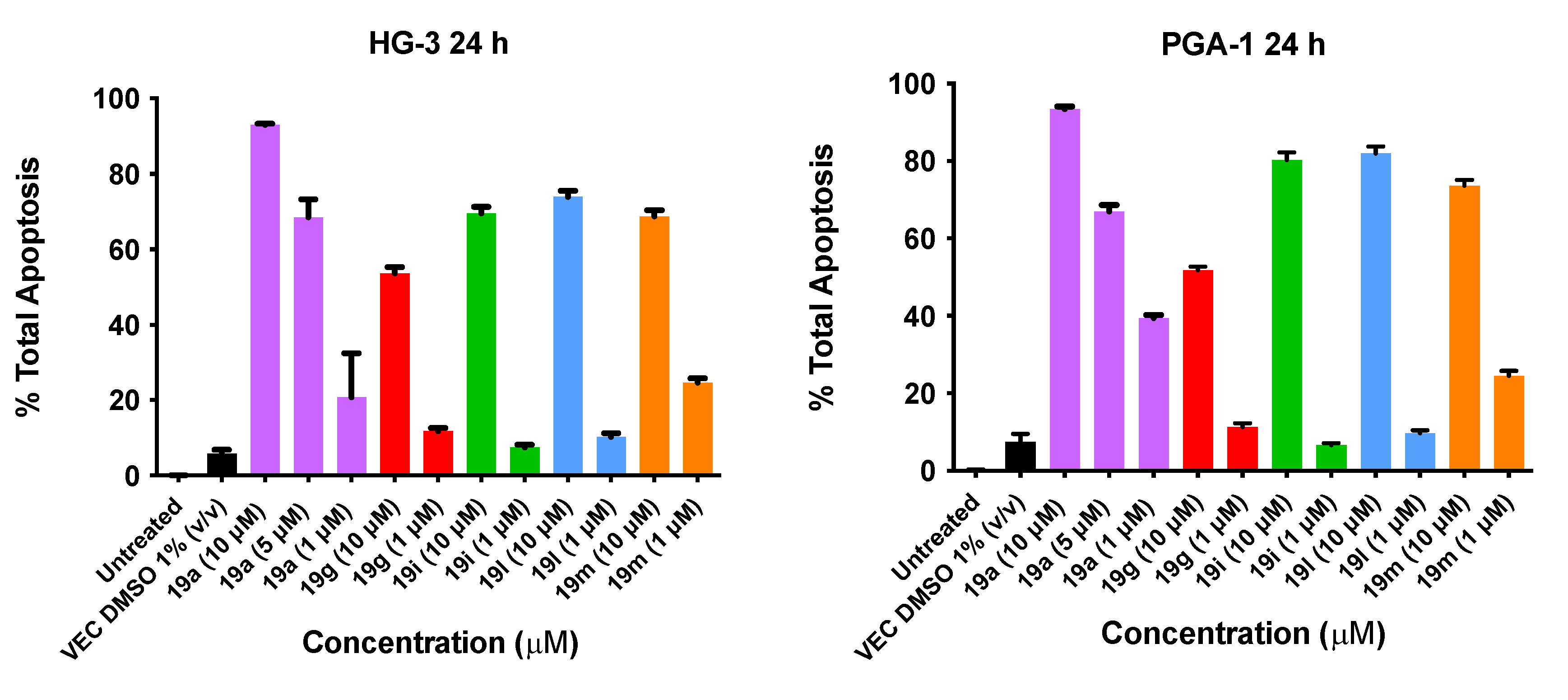
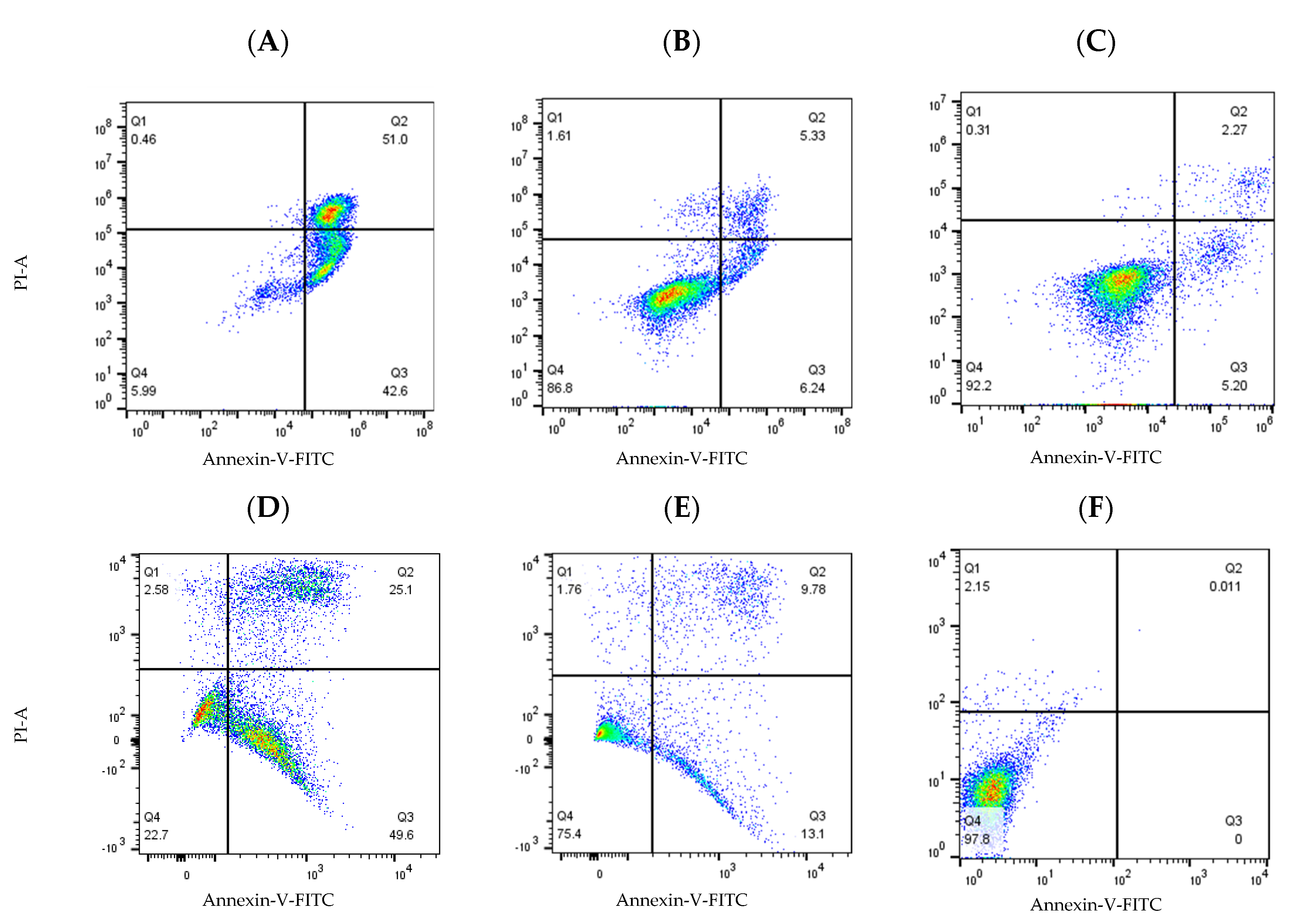
| Identification Code | 19f | 30a |
|---|---|---|
| CCDC No. | 2171050 | 2171051 |
| Empirical formula | C18H14ClNO2 | C16H11N3 |
| M (g/mol) | 311.75 | 245.28 |
| T (K) | 100(2) | 100(2) |
| Crystal system | Triclinic | Monoclinic |
| SG | P-1 | I2/a |
| a (Å) | 7.6352(6) | 19.6948(8) |
| b (Å) | 9.2984(7) | 8.6231(4) |
| c (Å) | 10.9972(8) | 28.1601(16) |
| α (°) | 75.948(2) | 90 |
| β (°) | 73.807(3) | 96.109(3) |
| γ (°) | 73.774(3) | 90 |
| V (Å3) | 708.31(9) | 4755.3(4) |
| Z | 2 | 16 |
| Dcalc (g/cm3) | 1.462 | 1.370 |
| μ (mm−1) | 0.276 | 0.661 |
| F(000) | 324.0 | 2048.0 |
| Crystal size (mm3) | 0.538 × 0.193 × 0.034 | 0.21 × 0.05 × 0.03 |
| Radiation | Mo Kα (λ = 0.71073) | Cu Kα (λ = 1.54178) |
| Reflections collected | 19,022 | 23,858 |
| Independent reflections | 3423 Rint = 0.0613, Rsigma = 0.0440 | 4475 Rint = 0.1027, Rsigma = 0.1008 |
| Data/restraints/parameters | 3423/0/200 | 4475/264/502 |
| Goodness-of-fit on F2 (S) | 1.041 | 0.947 |
| Final R indexes (I ≥ 2σ (I)) * | R1 = 0.0501, wR2 = 0.1194 | R1 = 0.0742, wR2 = 0.1939 |
| Final R indexes (all data) | R1 = 0.0809, wR2 = 0.1361 | R1 = 0.1678, wR2 = 0.2666 |
| Largest diff. peak/hole (eÅ−3) | 0.84/−0.31 | 0.34/−0.31 |

| % Viable Cells Remaining | ||||||||||||||
|---|---|---|---|---|---|---|---|---|---|---|---|---|---|---|
| HeLa 24 h | MCF-7 72 h | Ramos 24 h | Bjab 24 h | HL60 24 h | MUTU-1 b 24 h | DG-75 b 48 h | ||||||||
| 10 µM | 1 µM | 10 µM | 1 µM | 10 µM | 1 µM | 10 µM | 1 µM | 10 µM | 1 µM | 10 µM | 1 µM | 10 µM | 1 µM | |
| 11g | 34.2 | 87.1 | 41.7 | 81.4 | 7.7 | 53.4 | 51.9 | 82.2 | 16.5 | 73.4 | 14.91 | 44.16 | −0.08 | 75.86 |
| 11h | 23.2 | 90.6 | 29.7 | 94.3 | 5.1 | 27.2 | 46.2 | 90.1 | 6.8 | 78.2 | 10.28 | 39.80 | 0.38 | 84.50 |
| 11i | 17.7 | 93.0 | 37.1 | 102.7 | 13.9 | 62.6 | 50.8 | 100.5 | 6.5 | 103.8 | 10.53 | 67.22 | 0.72 | 88.76 |
| 11j | 21.8 | 95.3 | 20.7 | 98.1 | 4.4 | 66.9 | 68.9 | 102.4 | 9.1 | 99.8 | 10.27 | 64.31 | 15.89 | 79.77 |
| Taxol | 48.4 | 86.9 | 75.0 | 100.8 | 24.9 | 69.3 | 80.2 | 97.6 | 69.7 | 97.6 | 7.0 | 32.0 | 40.0 | >90 |
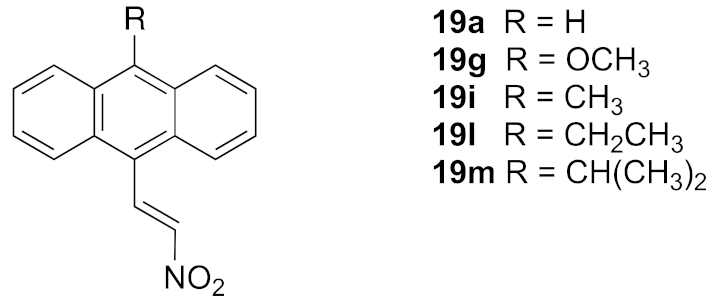 | |||
|---|---|---|---|
| Compound Number | HG-3 IC50 (µM) a | PGA-1 IC50 (µM) a | logP b |
| 19a | 2.43 | 3.10 | 4.57 |
| 19g | 0.17 | 1.29 | 4.49 |
| 19i | 3.85 | 4.40 | 5.07 |
| 19l | 5.40 | 1.30 | 5.59 |
| 19m | 0.70 | 9.10 | 5.99 |
| Fludarabine | 28.1 | 32.0 | −2.5 b |
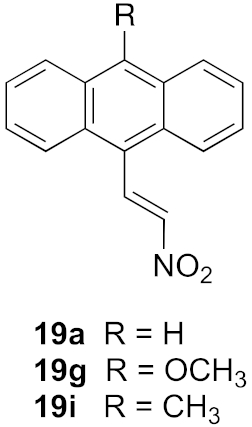 | ||
|---|---|---|
| Compound | MCF-7 IC50 (μM) a | MDA-MB-231 IC50 (μM) a |
| 19a | 1.85 | 3.82 |
| 19g | 5.31 | 3.78 |
| 19i | 2.11 | 3.26 |
| Tamoxifen b | 4.12 | 20 |
| Compound | Concentration | MUTU-I | DG-75 |
|---|---|---|---|
| (µM) | Apoptosis (%) | Apoptosis (%) | |
| 11g | 10 | 80.9 | 70.6 |
| 11h | 10 | 82.6 | 92.0 |
| 11i | 10 | 84.5 | 86.4 |
| 11j | 10 | 88.3 | 72.3 |
| 11k | 10 | 91.5 | 90.7 |
| 11l | 10 | 91.3 | 85.0 |
| Taxol | 10 | 87.3 | 72.8 |
| Taxol | 1 | 62.8 | 20.7 |
| Vehicle | Ethanol | 13.7 | 1.05 |
| Compound Number | Overlay of Anthracene Compounds (Green) with Maprotiline (Pink) | Overlay (F) Score a | Overlay (S) Score a | IC50 (μM) HG-3 Cell Line b | IC50 (μM) PGA-1 Cell Line b |
|---|---|---|---|---|---|
| 19a |  | −137.5 | −55.7 | 2.43 | 3.1 |
| 19g | 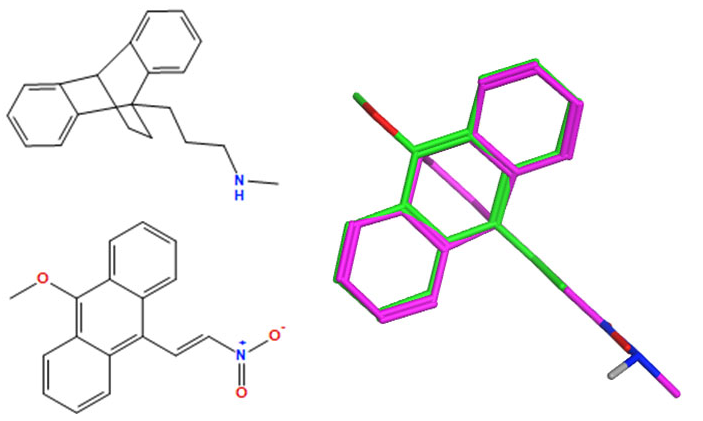 | −133.8 | −43.0 | 0.17 | 1.29 |
| 19i | 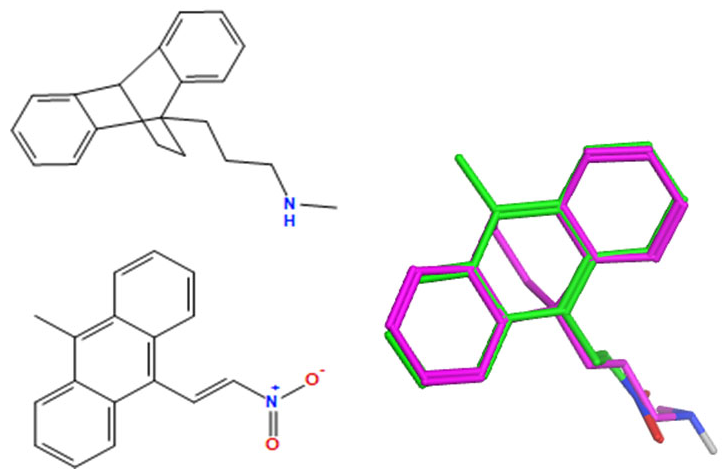 | −140.4 | −52.4 | 3.85 | 4.40 |
| 19l | 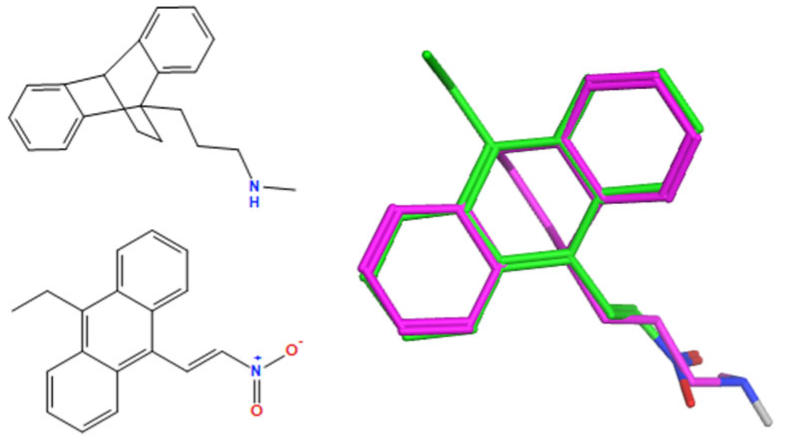 | −140.2 | −52.0 | 5.40 | 1.3 |
| 19m | 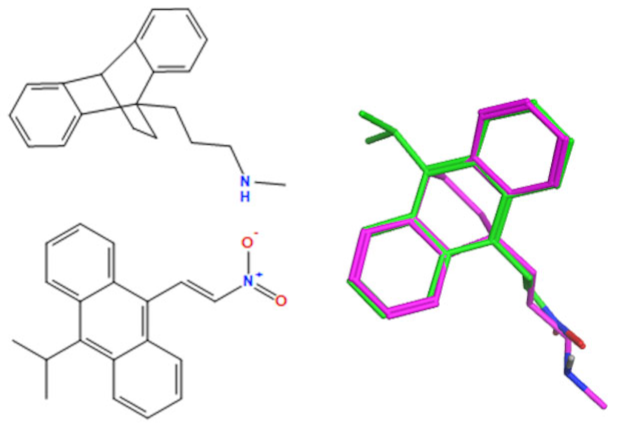 | −140.4 | −47.3 | 0.70 | 9.10 |
| Compound Number | Overlay of Nitrostyrene Compounds (Green) with Maprotiline (Pink) | Overlay (F) Score a | Overlay (S) Score b | % Viability HG-3 (10 μM) b | % Viability PGA-1 (10 μM) b |
|---|---|---|---|---|---|
| 11c | 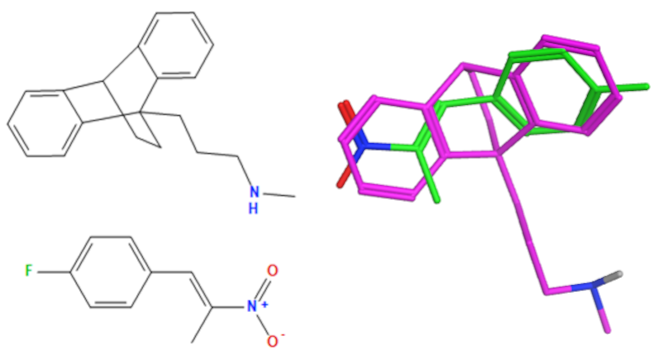 | −102.8 | −39.3 | 8.76 | 3.70 |
| 11d | 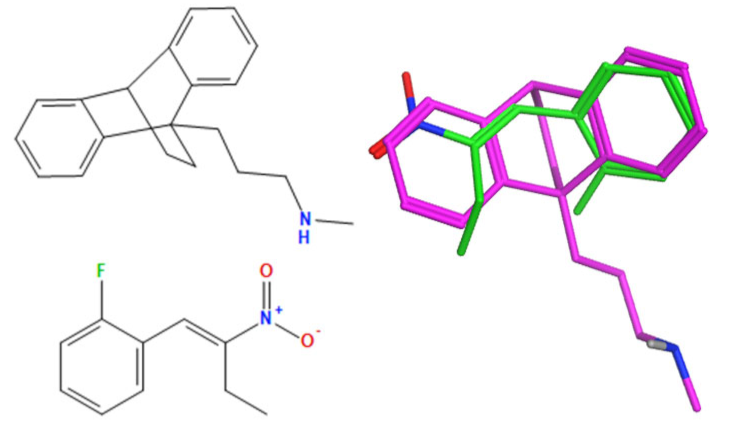 | −108.9 | −44.7 | 0.66 | 0.02 |
| 11j | 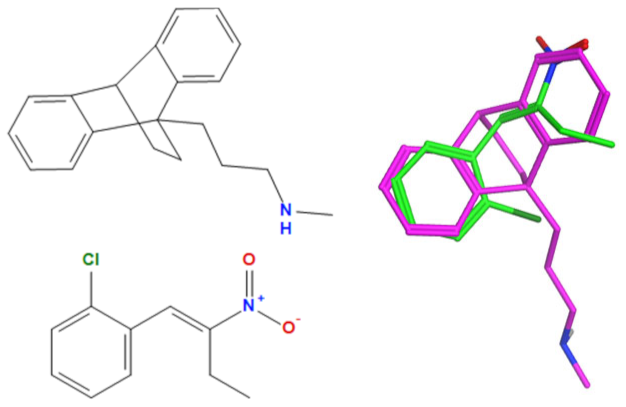 | −107.2 | −41.5 | 5.61 | 0.53 |
| 11k | 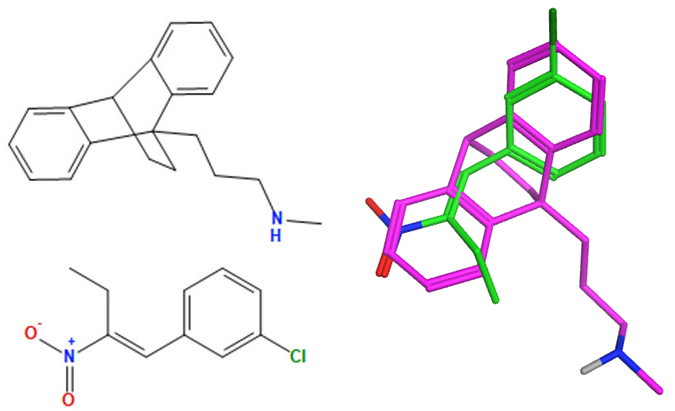 | −103.1 | −41.8 | 0.11 | 4.34 |
Disclaimer/Publisher’s Note: The statements, opinions and data contained in all publications are solely those of the individual author(s) and contributor(s) and not of MDPI and/or the editor(s). MDPI and/or the editor(s) disclaim responsibility for any injury to people or property resulting from any ideas, methods, instructions or products referred to in the content. |
© 2023 by the authors. Licensee MDPI, Basel, Switzerland. This article is an open access article distributed under the terms and conditions of the Creative Commons Attribution (CC BY) license (https://creativecommons.org/licenses/by/4.0/).
Share and Cite
Byrne, A.J.; Bright, S.A.; McKeown, J.P.; Bergin, A.; Twamley, B.; McElligott, A.M.; Noorani, S.; Kandwal, S.; Fayne, D.; O’Boyle, N.M.; et al. Synthesis and Pro-Apoptotic Effects of Nitrovinylanthracenes and Related Compounds in Chronic Lymphocytic Leukaemia (CLL) and Burkitt’s Lymphoma (BL). Molecules 2023, 28, 8095. https://doi.org/10.3390/molecules28248095
Byrne AJ, Bright SA, McKeown JP, Bergin A, Twamley B, McElligott AM, Noorani S, Kandwal S, Fayne D, O’Boyle NM, et al. Synthesis and Pro-Apoptotic Effects of Nitrovinylanthracenes and Related Compounds in Chronic Lymphocytic Leukaemia (CLL) and Burkitt’s Lymphoma (BL). Molecules. 2023; 28(24):8095. https://doi.org/10.3390/molecules28248095
Chicago/Turabian StyleByrne, Andrew J., Sandra A. Bright, James. P. McKeown, Adam Bergin, Brendan Twamley, Anthony M. McElligott, Sara Noorani, Shubhangi Kandwal, Darren Fayne, Niamh M. O’Boyle, and et al. 2023. "Synthesis and Pro-Apoptotic Effects of Nitrovinylanthracenes and Related Compounds in Chronic Lymphocytic Leukaemia (CLL) and Burkitt’s Lymphoma (BL)" Molecules 28, no. 24: 8095. https://doi.org/10.3390/molecules28248095
APA StyleByrne, A. J., Bright, S. A., McKeown, J. P., Bergin, A., Twamley, B., McElligott, A. M., Noorani, S., Kandwal, S., Fayne, D., O’Boyle, N. M., Williams, D. C., & Meegan, M. J. (2023). Synthesis and Pro-Apoptotic Effects of Nitrovinylanthracenes and Related Compounds in Chronic Lymphocytic Leukaemia (CLL) and Burkitt’s Lymphoma (BL). Molecules, 28(24), 8095. https://doi.org/10.3390/molecules28248095





